Oh yes it is. Much of the changes are due to innovation (China), and strong people standing up to the bullies of the West (such as Russia, Africa, and of course China). Much is not being reported in the Western “news”. It’s stealthy, don’t you know.
Instead we hear about how the West is “crushing Russia”, and how the evil Republican MAGA folk are a danger to “our democracy”. And of course, the evils of the vile Chinese. Blah. Blah. Blah.
Huawei New cellphone
Wow! Huawei’s latest cellphone no longer needs cellphone towers to operate. It runs as a “Satphone”. Meaning that it can place calls anywhere in the world without using cell-towers.
This WILL NOT go over well in the United States, as the American government and “law enforcement” relies on cellphones to track people, what they are doing and who they are talking with. Especially what they say. There’s an entire branch of government devoted to this effort.
It’s called the NSA.
The new phone runs on the UNHACKABLE Harmony OS system. Making this phone pretty much impossible to eavesdrop on.
Check out this short clip.
You might think that the United States government would then disband the NSA as it is now rendered superannuated.
But I don’t think that is what will happen.
Knowing what I know of this cluster-fuck of moronic ignoramuses, they will double down in spades.
They will probably suppress all Chinese technology, and fully ban Huawei phones. Probably accompanied with a propaganda campaign blaming China for eavesdropping on American privacy, etc etc.
Perhaps even work with an American company (such as the iPhone) for a super-dooper secure private phone. Promoted as the “safest phone, and most private phone ever”. Maybe even offering a reward or prize if someone can hack into it.
With a NSA “backdoor” of course. LOL
Banned Google on ShaoMi phones
It has been widely reported that Xiaomi device owners in China are blocked from installing Google Mobile Services (GMS), the core infrastructure for Google’s services and proprietary apps. However, only two months ago, Xiaomi refuted these reports, calling it a rumor.
The fact is, all Google Mobile Services are banned in China. This has been repeatedly confirmed by Google, LLC. All smartphone manufacturers in China launch their mobile devices without GMS due to the indiscriminate ban.
It should be emphasized, however, that smartphones, tablets and other mobile devices can function completely normal without any of Google’s services or proprietary apps (YouTube, Gmail, Play Store, etc.). No matter what the “news” might lead to to believe otherwise.
For instance, Xiaomi has its own Android-based mobile operating system called MIUI, which receives consistent updates.
It is a common misconception that Google owns the Android OS. In reality, the Android OS is a fully open source mobile operating system platform maintained by the Android Open Source Project (AOSP). Any manufacturer or developer in the world is free to use the Android source code to build their own Android-based OS. Google owns the brand name Android™, as well as the official Android™ logo.
In order for manufacturers to have their devices certified by Google and branded as Android ™ — and thus have Google’s services and proprietary apps preinstalled — these mobile devices must meet certain compatibility and specification criteria set forth by Google. Mobile devices with the Android™ branding are considered Google Certified (AKA “Play Protect Certified”).
So to fully answer your question, the answer is yes — Xiaomi (as well as other Chinese OEMs) is affected by the ban on Google Mobile Services (GMS), insofar as their inability to receive device certification by Google and thus preinstall GMS.
Xiaomi device owners in the US often install GMS and Google’s proprietary apps by way of sideloading APKs downloaded from third-party app repos and websites, such as The Open GApps Project
. Xiaomi device owners also flash their devices with a custom Android-based OS, such as LineageOS, followed by a pre-built Google services and apps installation package. As far as Xiaomi’s Android-based OS, MIUI, the manufacturer is in no way adversely affected by the China-wide ban on Google Mobile Services (GMS). Again, MIUI is regularly developed, maintained and updated by Xiaomi.
Bilateral trade as opposed to International trade
Currently, the RMB is only used for bilateral trades. And there are lots of examples of that.
China’s entire trade strategy is built on using a series of bilateral trades, which is quite different from the US strategy of using a multilateral organization.
—
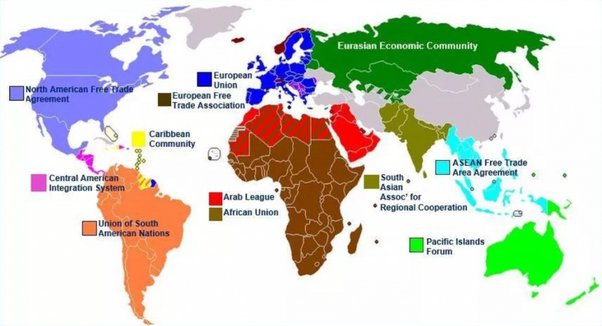
What is a Trading Bloc (Everything You Need to Know in 2019)
Take a look at the above image of trade blocs worldwide. Notice something unique about China? 🙂
You see, in a multilateral organization, such as a trade bloc, there are many nations, usually each with their own rules, including currency. Everybody wants to use their own currency, and nobody wants to use anybody else’s currency. Thus, the US Dollar is used as a compromise – it is nobody’s currency, so nobody gains an advantage over the other.
(Obviously the exception is the USMCTA, formerly known as NAFTA. The US is able to demand Canada and Mexico use US dollars because, well, the US is that much stronger)
—
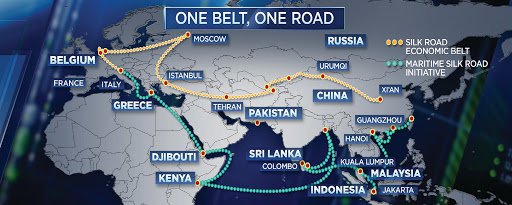
By contrast, this is China’s grand strategy – the Belt and Road Initiative. It is clearly not a trade bloc. All trade is done bilaterally. China and Kenya have an agreement. China and Djibouti have an agreement. But Kenya and Djibouti do not have an agreement.
When China and Kenya do business, they can exchange using RMB and Kenyan shillings. When China and Djibouti do business, they can exchange using RMB and Djiboutian francs. Or at least that’s the goal. If a country doesn’t want to do this, China and the bilateral partner will simply use the US dollar – at least for a time.
—
Thus, while the RMB is indeed part of the IMF reserve currency basket, and most major economies do hold a certain amount of RMB in their central banks to help facilitate trade with PRChina, those nations do not actually use the RMB for international trade.
What will happen if more countries use RMB instead of USD on International Trade?
Nothing there is absolutely nothing they can do… I mean there are 14 countries who want to completely decouple from China, they don’t say it outright, but their actions certainly confirm it.
The USA and those 14 countries hate the country of China, the CCP as the leadership, and by extension the Chinese people, because they are the party, the history, the ancestors to, the art and culture of China.
181 countries throughout the world are working with China on some of their largest infrastructural projects as well as shared technological projects, certainly the new Thorium Molten Salt Nuclear Power generation is going to be out there.
China is asking for those re-payments to be made in Digital RMB.
SWIFT and the USD as the international trading dollar is going down, whether you want to believe it… it is going to happen.
BTW, McKinsey & Co were just quoted on Bloomberg that China has officially passed the US as the richest country in the world.
SL-1
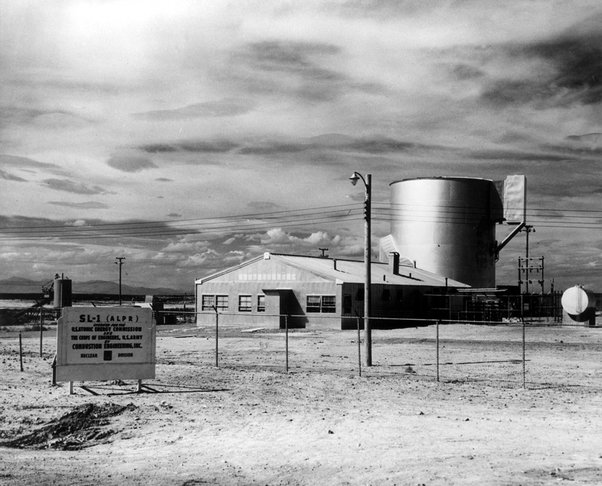
Ever heard of SL-1?
According to a report by the Los Alamos National Laboratory, there were 60 criticality accidents
between 1945 and 1999. All told, these incidents claimed a total of 21 lives. Seven of these fatalities took place in the United States, and three of them occurred almost simultaneously on the night of January 3, 1961, at the site of SL-1.
Stationary Low-Power Reactor Number One—“SL-1” for short—was a small experimental nuclear reactor built by the US Army. It was located at the National Reactor Testing Station (NRTS), a remote facility 40 miles west of the town of Idaho Falls, Idaho. The reactor was undergoing tests to see if it could provide suitable amounts of heat and electrical power to remote army bases north of the Arctic Circle and in the DEW Line.
On the night of January 3, three technicians were getting ready to fire up SL-1 after it had been shut down for the holidays. Army Specialist Richard Leroy McKinley (27), a trainee, was observing the routine maintenance procedure, standing off to the side; Army Specialist John A. Byrnes (22) was the one actually performing the operation (standing on top of the reactor); and Navy Seabee Construction Electrician First Class Richard C. Legg (26) was supervising, likewise standing atop the reactor.
Something, however, went wrong. Badly wrong.
At 9:01 PM, an alarm went off at the NRTS security station. A heat sensor in the reactor room had detected an unusual spike in temperature. Six firemen immediately suited up to respond, though they probably weren’t expecting much: two false alarms had occurred earlier that day. As they approached the reactor site, the firemen noticed that steam was rising from the Support Facilities Building (where the reactor was housed), but that wasn’t unusual for a cold January night in Idaho.
The firefighters attempted to hail the technicians known to be working inside the Support Facilities Building, but received no answer. A security guard opened the gate for them. The firemen donned their Scott Air-Paks and went inside to investigate.
At first, nothing appeared out of the ordinary—except for the fact that McKinley, Byrnes, and Legg were nowhere to be found. Three still-warm mugs of coffee were sitting in the break room. Three winter coats still hung from their pegs. Puzzled, the firefighters moved on to the reactor control room.
That’s when they saw the radiation warning light glowing angrily on the control panel. That was the first sign of trouble.
As the firemen climbed the stairs towards SL-1’s reactor room, their handheld radiation detector suddenly roared to life. The indicator jumped beyond its maximum range—200 röntgens per hour (R/hr). Thinking (or perhaps hoping) that the device was malfunctioning, the firefighters returned downstairs and retrieved a second detector. The readings on this new machine also maxed out as they climbed the stairs. The firemen retreated once again.
At 9:17, a US Army health physicist arrived. He and the assistant chief firefighter, with oxygen tanks and masks, started for the stairs to the reactor room. Their radiation detectors jumped to 25 R/hr, and they briefly withdrew. Armed with a higher-range ion chamber detector, the two men attacked the staircase again. The detector registered 500 R/hr as they climbed.
When they reached the top of the staircase and peered into the reactor chamber, they couldn’t believe their eyes. The room was dim, and filled with steam. The floor was strewn with gravel, rocks, twisted metal, and other debris. There even appeared to be pieces of the reactor embedded in the ceiling. The two men saw nobody, either living or dead. Stunned, they went back downstairs to await the arrival of SL-1’s lead health physicist, Ed Vallario, and Operations Supervisor Paul Duckworth.
When Vallario and Duckworth arrived, they suited up, climbed the stairs to the reactor floor, and entered the reactor chamber proper. Poking through the wreckage, Vallario heard someone moaning in pain. He found McKinley, unconscious and in shock, his battered body all but buried under debris. Vallario and Duckworth located Byrnes soon thereafter, dead, his body likewise battered and bloody. Legg was nowhere to be found. Vallario and Duckworth decided to head back outside and get help for the wounded McKinley.
McKinley’s rescue took two hours, and several members of the rescue team were forced to strip off their masks and breathe contaminated air in order to save him. He was eventually retrieved from the reactor room and loaded into an ambulance, but before the vehicle could reach nearby Highway 20, McKinley breathed his last. He was pronounced dead at 11:14 PM.
As McKinley was borne away, four more men entered the reactor room to search for Legg, the third SL-1 technician. Eventually, they located him…above their heads. What rescuers had initially thought was debris embedded in the reactor chamber ceiling was actually the body of Legg, pinned to the ceiling. He had been impaled by one of the reactor’s shield plugs. He, like Byrnes, had been killed instantly.
It quickly became apparent that a horrific accident had killed McKinley, Byrnes, and Legg. SL-1, for reasons unknown, had apparently ruptured with enough force to spray radioactive steam and debris all over the reactor chamber and kill all three of its operators—pinning one of them to the ceiling like some sort of grotesque holiday decoration.
The investigation of the accident’s cause had to wait until the bodies of Byrnes and Legg could be retrieved. A team of men recovered Byrnes’s corpse, coated with blood and steel pellets, the following night. Legg’s body proved problematic, for obvious reasons. Not only was it difficult to reach, but it was by far the most contaminated by radioactivity. It took four days to plan the operation. First, a welder, working from a lead-shielded box attached to a crane, cut open the reactor chamber ceiling. On January 9, a ten-man team, working in relays of two (each relay only being allowed 65 seconds in the reactor room apiece), used long poles with sharp hooks at the ends to snag Legg’s mangled corpse, free it from the shield plug, and drop it onto an enormous stretcher suspended from a crane outside the building.
With the retrieval operation complete, investigators set themselves the task of determining what had caused the accident that had claimed the lives of three young men in so gruesome a fashion.
They initially doubted that this was a criticality accident. SL-1 and reactors like it were believed to be completely safe, and incapable of going critical in such a drastic fashion. But forensic evidence proved otherwise. Neutron-activated materials in the deceased men’s effects—copper-64 in McKinley’s cigarette lighter and the band of Byrnes’s wristwatch, and gold-198 in Legg’s wedding ring—conclusively proved that the reactor had gone prompt critical.
This, in turn, indicated that the reactor had undergone a power excursion. Investigators were later able to determine that SL-1, designed to operate at three megawatts, had jumped to a staggering 20 gigawatts in the span of four milliseconds. This power excursion—6,000 times what the reactor was rated for—had caused the event which subsequently killed the reactor’s three operators.
But what had caused the excursion?
A vital clue lay in the procedure which Legg, Byrnes, and McKinley had been performing the night of January 3, and the design of SL-1. The reactor was designed to have a large central control rod which was capable of greatly accelerating the nuclear reaction in SL-1’s core if it was removed too far. Part of SL-1’s pre-startup checklist required the technicians to pull this rod up four inches in order to connect it to its drive mechanism. Post-accident analysis, including examination of scratches found on the rod, revealed that the rod, instead of being withdrawn four inches from the reactor assembly, had been withdrawn twenty inches.
The results were catastrophic. With the rod withdrawn so far, nothing could stop the nuclear fission reaction going on inside the reactor from racing out of control. A 20-gigawatt power excursion ensued, sealing the three technicians’ doom.
From Wikipedia:
In four milliseconds, the heat generated by the resulting enormous power excursion
caused fuel inside the core to melt and to explosively vaporize. The expanding fuel produced an extreme pressure wave that blasted water upward, striking the top of the reactor vessel with a peak pressure of 10,000 pounds per square inch (69,000 kPa). The slug of water was propelled at about 159 feet per second (48 m/s) with average pressure of around 500 pounds per square inch (3,400 kPa). This extreme form of water hammer
propelled the entire reactor vessel upward at about 27 feet per second (8.2 m/s), while the shield plugs were ejected at about 85 feet per second (26 m/s). With six holes on the top of the reactor vessel, high pressure water and steam sprayed the entire room with radioactive debris from the damaged core. A later investigation concluded that the 26,000-pound (12,000 kg, or thirteen short tons) vessel had jumped 9 feet 1 inch (2.77 m), parts of it striking the ceiling of the reactor building before settling back into its original location, and depositing insulation and gravel on the operating floor. If not for the vessel’s #5 seal housing hitting the overhead crane, the pressure vessel had enough upward momentum to rise about 10 feet (3.0 m). The excursion, steam explosion, and vessel movement took two to four seconds. The spray of water and steam knocked two operators onto the floor, killing one and severely injuring another. The No. 7 shield plug from the top of the reactor vessel impaled the third man through his groin and exited his shoulder, pinning him to the ceiling.
(Did you see the part about the shield plugs being ejected at 85 feet per second? Jesus Christ. Poor Legg.)
Having established that Byrnes had withdrawn the control rod too far and caused the disastrous power excursion that killed him and two other men, investigators were left with only one question.
Why?
Why had Byrnes, a trained technician, made such an egregious breach of protocol and committed such a foolhardy and dangerous act?
Theories ranged from the mundane to the outlandish: suicide, murder-suicide, an attempt to smooth the rod’s transition in and out of the reactor, or simple clumsiness. The best theory investigators were able to come up with (based on post-accident experimentation) was that the control rod had become stuck as Byrnes withdrew it, and in his attempts to jar it loose, Byrnes accidentally withdrew it too far, causing the power excursion and the resulting movement of the reactor vessel.
But the truth is…we’ll never know.
The only three witnesses to the event—Byrnes, McKinley, and Legg—were either killed outright or died shortly afterward, denying us their testimony. There were no CCTV cameras which captured the event. We’ll never know exactly why Rod No. 9 was withdrawn twenty inches instead of the regulation four. The mystery of the SL-1 incident will never be solved.
Chili Chicken Soup with Cilantro Dumplings
Honorable Mention Bisquick® Recipe Contest 2010! Try a new take on delicious dumplings with chiles, cumin and cilantro to create an extra yummy soup.

Ingredients
Soup
- 1 tablespoon vegetable oil
- 1 1/4 lb boneless skinless chicken breasts, cut into 1-inch cubes
- 1 medium onion, chopped (1/2 cup)
- 3 teaspoons chili powder
- 1/2 to 1 teaspoon salt
- 5 cups Progresso™ chicken broth (from two 32-oz cartons)
Dumplings
- 2 cups Original Bisquick™ mix
- 2/3 cup milk
- 1/2 cup chopped fresh cilantro
- 1/2 teaspoon ground cumin
- 1 jalapeño chile, seeded, chopped, if desired

Do the Chinese hate Americans collectively or are they pretty apathetic towards them?
As an American who has lived in China and wastes way too much time watching Douyin, I think I am qualified to answer this question.
Average people in China still idolize America and Americans quite a lot, and in my honest opinion, wayyyyy more than we actually deserve.
The average Chinese citizen is patriotic because their education does a decent job at conveying to them the legitimacy of their current government and the historical conditions that brought it to power.
At the same time, however, the opinions of the Chinese people have been colored, not by politics, but by the heavy contrast in the US cities they’ve seen in Hollywood movies versus the cities around them growing up.
The simple fact is, the US is a more developed nation, and for a developing nation like China, this is something to aspire to.
The average Chinese person does not have a highly politically-charged perspective of all things, and so they take it at face value — regardless of the amount of exploitation that might have taken place in order to get it to this point, the Chinese people still see the US’s development as a good thing.
Of course, Chinese cities are more developed now, so this sentiment will probably change pretty soon:
Even the better historically-informed of the Chinese population will indeed have a handful of reasons to like and respect the US: some of those being, the US assistance in the war against Japanese aggression, as well as a touching example of heroism in the form of Minnie Vautrin, a teacher in Nanjing who sheltered and saved thousands of Chinese women and children during the rape and massacre on the city by the Japanese in 1937.
I’ve never had a negative reaction from a Chinese person on account of my nationality. To the contrary, I’ve been nothing but welcomed, invited to homecooked dinners, and treated with all the warmth and respect in the world. Now there are a handful of young people these days in China who have a much deeper grasp of geopolitics, and so they might take a more anti-US position. But these people are few and far between and even the most nationalistic among them would not try to pick a fight with you on the street or anything. They’d likely just be a bit more dismissive than everyone else. All in all, Chinese people know their history and have confidence in their country — they have no reason to demonize others. Their primary goals are to see their own country and people thrive.
Pentagon caught using UFO’s and Space Force in stunning military move | Redacted with Clayton Morris
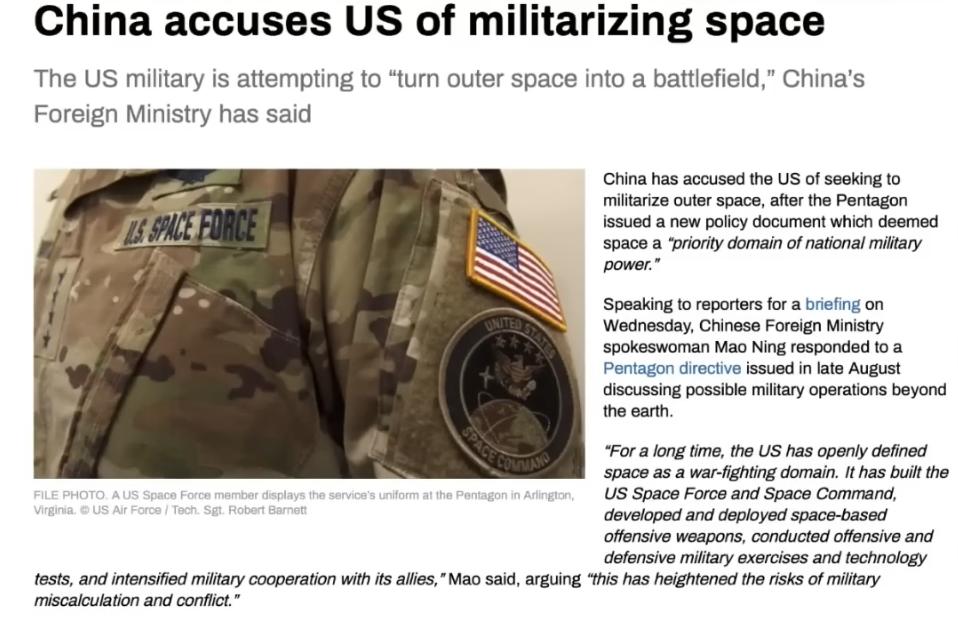
Check out this video.
Can modern Chinese people read and understand ancient Chinese texts?
On August 15, 2017, the archaeological team of Genghis Khan University in Mongolia found a large number of carved characters on a cliff of khangai mountains Mountain in present-day Mongolia.

These Ancient script confused the Mongolians at that time; they could not understand the meaning of these ancient characters. But some knowledgeable professors think they are Chinese http://characters.So they invited a Chinese archaeological team to study on the scene, and the Chinese soon discovered that the characters were in Chinese, and In AD 89, people of the Han Dynasty wrote about this trip during the northern expedition to the Xiongnu.they could easily read them, thus deciphering the meaning of the inscription.
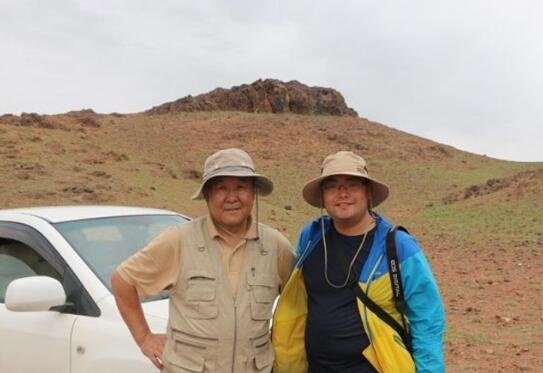
They checked the ancient books of the Han Dynasty and found that it was “封燕然山铭” written by Ban Gu (班固)of the Han Dynasty in China more than two thousand years ago, because the text on the stone was exactly the same as the original text of “封燕然山铭” in the history of the Han Dynasty in China. 封燕然山铭 means the inscriptions carved at the Higher of Yanran mountain.
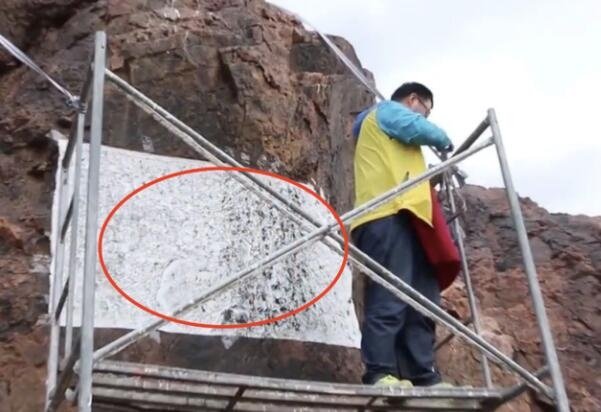
Yanran mountain (燕然山)refers to khangai mountains mountain in Mongolia.
Because the position of this inscription is relatively high, it is right in the middle of the cliff, so herdsmen who pass by are generally inaccessible. And, this place is relatively remote, stone mining merchants will not come, so it is very lucky to survive.
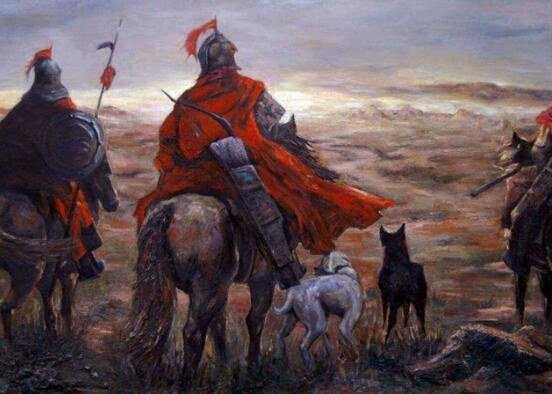
In 89 AD, after Dou Xian led the army to defeat the Xiongnu, he inscribed his achievements in defeating the Xiongnu on the cliff at the southern foot of Yanran Mountain (Hangai Mountain in present-day Mongolia). It publicizes the achievements of the last war between the Eastern Han Dynasty and the Northern Xiongnu and the strength of the Han Dynasty. Later, “勒石燕然Establish meritorious service in Yanran mountain” is used as an allusion to establish or achieve meritorious deeds.
The inscription reads as follows:
这段铭文的内容为:
惟永元元年秋七月,有汉元舅曰车骑将军窦宪,寅亮圣明,登翼王室,纳于大麓,维清缉熙。乃与执金吾耿秉,述职巡御。理兵于朔方。鹰扬之校,螭虎之士,爰该六师,暨南单于、东胡乌桓、西戎氐羌,侯王君长之群,骁骑三万。元戎轻武,长毂四分,云辎蔽路,万有三千余乘。勒以八阵,莅以威神,玄甲耀目,朱旗绛天。遂陵高阙,下鸡鹿,经碛卤,绝大漠,斩温禺以衅鼓,血尸逐以染锷。然后四校横徂,星流彗扫,萧条万里,野无遗寇。于是域灭区殚,反旆而旋,考传验图,穷览其山川。遂逾涿邪,跨安侯,乘燕然,蹑冒顿之区落,焚老上之龙庭。上以摅高、文之宿愤,光祖宗之玄灵;下以安固后嗣,恢拓境宇,振大汉之天声。兹所谓一劳而久逸,暂费而永宁者也,乃遂封山刊石,昭铭盛德。其辞曰:
铄王师兮征荒裔,剿凶虐兮截海外。夐其邈兮亘地界,封神丘兮建隆嵑,熙帝载兮振万世!
The main idea is:
In the first year of Yongyuan in the Han Dynasty (AD 89), autumn, July; the prince’s maternal uncle-wuyang marquis 武阳侯-Dou Xian(窦宪), the general of the chariot army. He respected the emperor and assisted the royal family; Participate in national government affairs; He is noble and outstanding. He has a sense of justice and integrity.
He joined Geng Bing, the captain of the capital guard, and sent troops to the north. The soldiers are as mighty as eagles; The soldiers are as brave as dragons and tigers; This is the powerful army of the Empire. Except for the Imperial Army; The king of the southern Xiongnu; The barbarian Wuhuan(乌桓) in the East and the barbarian Rong(戎) in the West; The kings of Diqiang,(氐羌) etc., all led the army to follow the northern expedition of the Han Empire. There are more than 30000 troops in the army.
The chariot runs fast and runs wildly on the grassland; The logistics are vast, with more than 13000 vehicles.The army was divided into eight regiments; The cold iron armor glowed in the sun. Among them, what you can see is not the sky, but countless red military flags.
The army passed through gaoque高阙 (annotate :in the northwest of Hangjinhou杭锦后旗 County in Inner Mongolia today); Passing through Jilu鸡鹿要塞 Fortress (annotate:now Dengkou磴口 County in the west of Inner Mongolia Autonomous Region); After passing through the wilderness and the desert, he beheaded the “King Wenyudi 温禺鞮王 ” of the northern Xiongnu and smeared his blood on the drum to worship the heaven;Wash the swords with the blood of the “sigudu尸逐骨都 Marquis” of the Xiongnu.
After the rest of the army, they walked through the grassland like lightning and meteors; Where the Han army passed, there was a dead silence; A living Hun can’t see it.
After this land was completely conquered by the Empire, they consulted the map and walked through A large number of mountains and rivers; Cross zhuoye涿邪山 mountain, Cross the anhou安侯 River and climb the Yanran mountain冒顿. They destroyed the tribe of king maodun and burned laoshang老上 royal court. (annotate:Maodun here refers to the king of the Xiongnu (? – 174 BC), the first leader who made the Xiongnu strong, and a figure in the era just established in the Han Dynasty of China. Laoshang was also the emperor of the Xiongnu (? – 161 BC), and was the son of Maodun. After maodun death, Laoshang succeeded to the throne.The royal court site of the Xiongnu was found about 470 kilometers west of Ulaanbaatar, the capital of Mongolia (erejit County, houhang’ai province))
This can be regarded as helping Han Gao Emperor (annotate:the founding emperor of the Han Dynasty Liu Bang) and Han Wen Emperor (annotate:the second generation emperor of the Han Dynasty) to vent their anger; It can also be said to have won glory for the ancestors of the Great Han.
It can also be said that it provided a stable development environment for the descendants of the Central Plains and widened the territory of the Han Dynasty; Let the majesty of the Han Empire be publicized.This is a once and for all success; Although it was a little hard at this time, it could provide an environment for future generations to live and work in peace and contentment.Therefore, we climbed Yanran燕然 mountain and carved the great victory on it.
The end of the inscription is engraved with a summary sentence to the effect that:
The powerful, dignified and just imperial army fought everywhere. Exterminated all ferocious evils; They fought thousands of miles and reached the end of the earth. Seeing this sacred mountain, we decided to worship it. Build monuments, publicize the great deeds of the Empire, and give strong confidence to the people of all dynasties in the future.
the historical significance of the inscription is significant:
Qi mudaoerji, a professor at Inner Mongolia University, believes that in history, the Huns, Turks, Mongolians and other nomadic peoples in northern China stepped onto the historical stage one after another, but because their voices are not interlinked, they are also different in the inheritance of place names. This led to the incompatibility of many geographical terms in the ancient north with today’s information. This makes it very difficult to study and restore history.This archaeological discovery can fully confirm the location coordinates of Yanran mountain, and also confirm that Yanran mountain is a Xiongnu language.
This discovery also provided accurate geographical route information for the westward migration of the northern Xiongnu. In the year of Yongyuan yuan of the Eastern Han Dynasty (AD 89), Dou Xian, a general of the Han Dynasty, attacked the Xiongnu in the north and fought all the way to Yanran mountain, winning a great victory and almost annihilating the main force of the northern Xiongnu. At that time, Ban Gu, who accompanied the army, wrote Yanran mountain inscription. This is clearly recorded in the Historical record book of later Han Dynasty · Dou Xianchuan.
However, in ancient times, there was no concept of longitude and latitude, and the original Yanran mountain was also a large mountain range. Therefore, no one has ever known the exact location of the stone carvings in the Yanran mountain inscription. The battle of Yanran mountain is very famous in history. After this battle, the northern Xiongnu left the Mobei plateau and fled to the west.it
can be said that it indirectly caused the destruction of Western Rome.
China’s BYD signs land deal to build first EV plant in Thailand
Slow-Cooker Cheesy Chicken and Bacon Soup
How do you make chicken wild rice soup even better? Make it in the slow cooker, and add bacon!

Ingredients
- 4 slices thick-sliced bacon, chopped (4 oz)
- 1 tablespoon Gold Medal™ all-purpose flour
- 1 tablespoon Montreal chicken seasoning
- 1/2 teaspoon salt
- 1 package (20 oz) boneless skinless chicken thighs (about 6)
- 2 cartons (32 oz each) Progresso™ Chicken Broth Reduced Sodium
- 1 cup uncooked wild rice
- 1 bunch sliced green onions, whites and greens separated (1/2 cup whites, 1/2 cup greens)
- 1/2 cup diced celery
- 1/2 cup diced carrot
- 4 cups shredded sharp Cheddar cheese (16 oz)
- 1 cup heavy whipping cream


What corruption have you experienced in your life?
Indian here.
Here is the face of corruption in India which most other Indians on Quora have been fortunate to have never witnessed.
Previous answers by Indians have said so much about various aspects of corruption in India. Surely, almost everything that could be said has already been said.
Unfortunately, I can only wish that were the case.
Other answers by Indians have something in common… they are mostly written by reasonably well to do people who can write in English quite well and are able to write an essay length answer on Quora. This gives us a hint about the Indian demographic answering this question. Simply because of better education and sense of their rights, this demographic is largely isolated from the type of corruption that afflicts the others.
I belong to this group now… but I was part of a very different one during my childhood – the lower / lower-middle economic class. The corruption faced by the these classes is quite different, as you will soon see. I will only talk about those (skipping the usual all pervasive corruption related with driving license, passport, traffic tickets, etc).
A little background to set the ground work…
I come from a relatively poor, densely populated place in New Delhi (near Ambedkar nagar), where I had an exciting childhood growing up with a large number of friends (~25). I spent all my childhood mostly playing cricket. As one might expect, education was not a high priority. Only 7 of these friends stayed in school beyond 10th grade and just 3 studied beyond 12th. Everyone else dropped out for one reason or another, and their parents really didn’t care about it all that much. I was the only one who went on to get a masters.
A couple of my friends are bus drivers/conductors in commuter buses (red/blue line buses in Delhi) and a few others work as office peons – basically the Rs 5k-8k ($100) monthly salary bracket. My parents had emigrated to New Delhi 10 years before I was born, in search of a better life. Hindi and English were not their best languages, but they got by.
Here we go…
1. “Do not go to the police, no matter what”.
My sister was told by my parents – “In case of any incident (molesting, purse snatching, etc), DO NOT go to a police station – especially never after dark and never alone. Catch an auto rickshaw and come home right away…”.
This might be surprising to some… but enough incidences of poor young women being molested inside the police stations were known that this was just common sense of the place. Also, this is mostly a poor neighborhood issue. Policemen know enough not to try such atrocities in the more affluent neighborhoods.
I can hardly imagine the plight of the women who have been victims of a crime, and who go to the police station to seek some recourse, where they have to face further humiliation / molestation / injustice. Definitely makes them forget about the original problem in a matter of seconds.
2. “Do not report burglaries” or “Do not let the police know your economic status”.
This is a funny one, especially since its coming from the relatively poor.
When our house was burgled and the thief fled with a VCR and stereo (probably the TV was too bulky to run with), we did not report the incident to the police. Since bribery is such an integral part of life there, you don’t want the authorities to know your actual financial state (no matter what it actually is). If they don’t know your economic state, you can always plead that its worse than what they think – which we always did. But if they come to know that you owned a vcr/stereo or they see a 25″ color TV in the home, you are going to pay through the nose for the rest of your days. Also, the thief is not going to get caught anyway, and even if he is caught, you won’t get the stuff back… so no point in calling the police. This is another “common sense” rule of poor localities. Do not report burglaries and don’t let them see your house on the inside.
Of course, now you might ask, what happens if we catch a burglar in action? It seems that we would have to call the police in order to arrest the thief. Well… this depends on people’s disposition at that moment. Usually, people prefer to deal their own brand of justice to the thief and park him in the nearby doctor’s clinic rather than troubling the police (who would probably have beaten him worse – unless he was able to bribe his way out).
3. “In the land of the poor, the police are the mafia”.
When I was about 15, we used to play cricket in a park, which had a small illegally erected shack on one corner selling tobacco products ( staying in place by paying bribes to the police ). The person running this shack was never happy to see us play there. To this day, I fail to understand the root cause of his resentment – maybe he was just an unhappy person tormented by the system. Every time a ball was hit in the vicinity of his shack, he would give us angry looks, and tell us to go and play somewhere else. If a ball happened to fall harmlessly into his shack, he would make a hue and cry about it, give us dire warnings and we would never see the ball again.
One day, our ball hit a plastic candy jar kept on the edge of his shop, which fell to the ground. The guy flew into a rage, grabbed one of our bats, broke the stumps and we all got into a big argument. He called the cops and reported that we had broken things in his shack and roughed him up.
The cops, who are ever watchful for such an opportunity, promptly arrested the 3 kids they could get their hands on, bundled us into the gypsy (typical police car model in India) and took us to the police station. We tried to protest, for which, we got slapped sharply and were told to be quiet unless we wanted more.
At the police station, we were asked for our names, addresses, phone numbers and parent’s occupations, which were duly noted down (not an official FIR (crime report book), but in generic visitor log book). Then we were taken to a room which already had 3 other poor wretched looking men in a rooster (murga) position (for those who don’t know this stance, its an utterly self-disrespecting pose where the person completely bends over at the waist while the butt is held high suitable for caning – it becomes physically uncomfortable and painful after a couple of minutes).
We too were then asked to assume a rooster position until the Inspector was ready to deal with us. I now understand that they needed all our info to know how best to make a profit from this situation. From the addresses and parent’s occupation, the inspector deduced that our parents are too illiterate/ignorant to protest.
The officer came to the room where we were struggling to maintain the rooster stance. He kicked my friend who was a bit unstable, made him get up and slapped him viciously across the face. He grabbed a large lock of my friend’s hair and swung him around the room, saying… “You guys want to grow up to become dons… is it? Beating up the shop keeper and destroying his shop. Next, you will be asking for hafta (weekly ransom extracted by mafia).”. “No sir. We didn’t do anything. We were just playing cricket…” Of course, he knew that already. Silly us. Also, the irony of the situation probably didn’t dawn on the inspector – that he was doing exactly what he was accusing us of – taking bribes from the shopkeeper to let him run his business.
Each of us was slapped around by the inspector, and physically abused in a general manner for the next few minutes. And to further humiliate us, he told us to slap each other… we were forced to do it. He slapped me hard because I didn’t slap my friend hard enough. And we resumed slapping each other, harder this time, tears streaming down our faces.
In the meanwhile, they had also called our parents and summoned them to the police station to deal with the “grave matter”. They did not call all the parents at the same time, lest the parents get together and start protesting. They called each parent after they were finished dealing with the previous one. (This is my assumption of their plan – I can’t be sure if the cops planned it this way, or it just so happened that all the parents happened to arrive at the police station at separate times. From my other experiences with the cops, I believe it was planned.)
Once each kid’s parents arrived, they were told that releasing the kids for any amount of money was out of the question; the police have received a complaint from the shop keeper and the only thing they could do – for an appropriate price – was to “not beat the kids” while they were in the police station. ( This technically makes sense because what we received earlier is not really a Delhi police beating… they were merely “scolding” us. A beating usually requires hospitalization and leaves a person bed ridden for days.) Parents were told that the kids will be taken to a magistrate in 2 days time and they should arrange for a lawyer.
Of course, all of this was bullshit but our parents were too stupid to know it. All the talk was just to scare the parents to pay whatever they could muster. Our parents had seen cases to go courts and people not being able to afford the lawyer fees or the police and court bribes. Our parents pleaded and groveled in front of the police officer to take more money and let the kids go. The matter was finally settled for around 2000 per kid, which was a nontrivial amount for our economic state at the time (early 1990s).
This is not just a solitary incidence – there are tens of other similar horrific incidences endured by people known to me personally. The police are on the prowl for any hint of an activity which they can benefit from. We had a nickname for policemen… “sabse bada gunda” – “the biggest mobster/villain”. If they can’t make money from a person because the person is too poor, they physically abuse them for their own entertainment. I am sure every New Delhi resident has seen a poor guy being mistreated by a policeman (being slapped/kicked/beaten in public view). It’s usually assumed that the poor guy has deserved it and no more thought is given to the matter. You can see how this system can lead to alternative systems of justice like the ones depicted in the movie Sarkar (~Indian remake of Godfather).
4. “You can get slapped by a policeman at any time and for no reason”. There are too many incidences of getting slapped or beaten by policemen in the normal course of a day to be narrated here in detail. I do remember 2 incidences clearly, which I will describe below…
4a. This happened when I was about 20. I and a friend were hanging around late at night (11 pm), catching up on each other’s latest activities as we had been out of touch for more than an year (I had started college and was staying in the hostel, and came back home once every 3 months to visit). We were sitting at our usual get together spot where we used to wait for players to gather before going for playing cricket.
As we were happily talking away, I noticed a couple of policemen walking towards us. A dread took its grip over my mind, heart and throat. The policeman asked… “Who are you and where do you live?”. I took an audible gulp down my throat and answered “Right there Sir.”, pointing towards my house. “Go home and talk all you want in your house. I don’t want to see anyone loitering around here” he ordered.
Fortunately and unfortunately, the college scientific education was having an effect on me, where I was taught to not accept things without question. However, I didn’t realize that those teachings don’t quite apply outside the classroom. I mumbled “But sir, what has happened to warrant this? We have always spent tim…” BAMM!!! and he slapped me right across the face. “What did I just tell you? Move, else you will receive more.”
Why did the policeman slap me now while we had enjoyed that precise spot for years? I understood this the next day.
A new computer training shop had opened doors near my house about 6 months ago, and the shop owners had trouble getting girls to sign up for the training lessons. Apparently, some girls had been teased by boys loitering around the shop and the owner had paid the policemen to keep the area clear of loitering boys at all times.
4b. It is assumed by default that if you are roaming in a better location than where you belong, you are there for no good reason, or probably to plan a robbery. Incidences like the following one were repeated many times between the age of 10 and 17.
I was walking home from school one late evening after spending time at a friend’s house. I unfortunately managed to walk into 2 policemen on the way, while I was still in the “better” locality (I liked to walk this way because the houses and the roads were so nice). I am usually on the lookout for policemen while walking around, but this time, they sprung up on me as I rounded a corner. The expression on my face and the fear in my body language immediately gave it away that I was an outsider in this area, feared the police and have been at the receiving end of their abuse on earlier occasions. “I was one of those who feared the police on sight for no fault of mine.” I could not even make a run for it, though I did think about it for a second.
The next scene played out in a manner similar to how it had already played out many times on earlier occasions… “What’s your name and where do you live?”. I was so stupid and scared that I never thought that I could lie to these guys and slip away. Naah… if they ever came to know I had lied, they would beat me to death and I would have deserved it. Now, I can get away with a few slaps and only getting my hair pulled mercilessly, and promise to never come to this place again. Now that I think of it… I should have kept my hair cut really short – maybe get my ears clipped as well (the cops loved pulling those too) – basically keep all body parts inside the body.
5. “Authorities take extra advantage of poor/ignorant people”.
An answer by another Indian for this question claimed that poor Indians face lesser corruption in India (as compared to more affluent ones)… I laughed a little on the outside and cried on the inside. Only if they knew.
We (family of 5) lived in a tiny house having only 1 room and a total area of 200 sqft. As we kids grew up, some of us had to sleep on the roof in order to not bump into each other during the night. When it rained, all of us had to fit into the 1 room. Good times – I loved it.
My father had saved some money over a period of 15 years to extend the house (add a bedroom / bathroom), but the building laws and provisions did not allow for any construction/extension at all (or that is what we were told by the authorities and we were too dumb to read and understand all the laws. The fact that my parents were not fluent in English and Hindi made matters worse. And how can the authorities lie about laws?). They said we needed to file for special permission from the building authority for the new construction. That the procedure will take about 6 months to complete as the signing authority is extremely busy with other cases…. of course, for X amount of money, it can be done in a few days. Everyone else we knew around us was also equally dumb and was being taken for a similar ride by the authorities (hence, at the time, we didn’t know for sure that we were being fooled – we really thought that they were doing us a favour (for a price)). The poor have to pay bribes even for legitimate constructions.
We had no option – my father had to pay the bribe. Or else, stay in the 1 room for… eternity?
As soon as construction began, the police could smell some money being spent and they wanted their share. My father believed that the authorities and police were colluding and that the police had been informed about the construction by the building authorities. They came to inspect the building activity and demanded to see all the paperwork – today I know that the police had no business conducting such ‘inspections’, but the poor can’t question the police. Also, there are always some papers which you won’t have. Or they will make up some bullshit paper that you needed, right out of thin air. And while they are conducting their ‘inspection’ and negotiating the ransom, the construction work is halted, preferably with the concrete in a half poured state. They are good at their stuff. And you can’t complain to anyone because you are not smart enough to know that you might be right and have all the required paperwork. You can’t really complain about the police to anyone… what if the police come to know about it? They have arrested and beaten people in lockups on no/fake charges many times before… what’s going to happen if they knew you complained against them?
And even if you decide to complain, who are you going to complain to… and why would they take your side in this argument? From a poor man’s perspective, all authority is allied with each other. Every time you have dealt with authority in the past, each and every one of them, without exception, has tried to make more money off you. Its much more easier to just pay these guys to go away. It doesn’t even help to ask around if you really have made a mistake, because no one around you is smart enough to know all these details… because, if they were smart, they won’t be living around you. Only the authorities know this stuff and they are not on your side. Anyway… we paid again.
And we were forced to pay money again and again and again… whenever we had to deal with the authorities, for each and every thing that we didn’t understand. Sometimes we did know everything, but then, they would construct fake and arbitrary hurdles for us to jump over (they can tell who’s stupid). Its paying for your lack of education in real and hard currency. I think that’s the reason why my parents made sure that the kids got well educated despite it costing more. We were the only kids in the neighborhood who went to English medium schools (for the foreign readers – English medium school = language of tutoring is English rather than Hindi for all non language subjects like math, science, history, etc).
Cop in training:
I remember another childhood experience (~12 years old) where a novice policeman was practicing his bullshitting skills. I was riding my bicycle on a main road when a cop stopped me and asked me for my bicycle license. I had no idea that I needed a license and immediately felt stupid and guilty at the same time. I timidly said that I did not have it, whereupon he scolded me “You should know that you need a bicycle license to ride on a main road. Do you have any idea how dangerous it can be?”. He asked me to get off the bicycle, confiscated it and told me that I will have to pay the fine of Rs 20. (In case any non-Indian is wondering, there is no such thing as a “bicycle license” in India).
I started crying and I told him that I was very sorry and that I didn’t have any money. He told me to go and get money from my parents and then he will release the bicycle. I didn’t want to go and tell my parents that I had got into trouble for which they needed to pay money – they had previously told me to keep off the main roads while riding my bicycle – now I had done 2 bad things – didn’t listen to them and got fined. I spent the next half an hour crying, pleading, groveling and appealing to his merciful side to kindly let me go. Finally, realizing that nothing is going to come out of this, he let me go, probably making a mental note of what to change in his strategy the next time around.
A slice of my father’s struggles…
My father has endured much more abuse from authority in his life, but I never discussed these at length with him. However, I did see him struggle with this menace for most of his life. Throughout his life, my father worked hard and saved money to realize his dream of a better life for himself and the family. Once the kids became independent, he bought a plot of land on the city’s outskirts (greater noida) to set up a workshop to sew readymade clothes. He was 70 years old at this time and traveling ~80 kms everyday to get all the necessary clearances/paperwork and spending his hard earned money on bribes.
He was doing these trips in a beaten up old car that he had brought so he could do this quickly (he didn’t have much time or energy). Even though he was resigned to paying bribes, they made him run from pillar to post, so they could demand even more money than he was offering them upfront. For a 70 year old man, he was tormented in an inhuman way by the officials, but he persevered. I have no doubt he would have been able to pull off this project of his.
Unfortunately, he was finally broken by an untoward incident. One fateful day, a riot broke out (probably against police brutality) in a couple of villages/towns in the Greater-Noida area, where my dad was passing through on his way to the authority’s office. The rioters blocked the road and stopped the car, broke the windows, pulled my father out of it and set the car afire right in front of his eyes. He is the most determined person that I know, but he could not recover from that. What the government officials could not achieve with years of abuse and torment, was achieved by the rioters. He could fight the system… but now the general people had attacked him… it rends my heart as I re-live all this. I had not cried in the last 15 years, but remembering and writing all this brings back terribly painful memories.
Often in the movies, I had come across the question “If you knew that this was the last day of your life, how would you spend it?”.
Until the age of 20, my “perfect last day” was to get a machine gun and go around killing each and every policeman and government official that I could lay my bullets on. I had dreamt / romanticized about this so often in my mind that things could have easily gone in that direction, had life continued to be the hell that it was.
I once explained to a higher economic class friend about some of the pain that we had to go through. I must not have explained it very well because they said…
“You are trying to do things which you are not capable or smart enough to handle properly. If you don’t handle it properly, nobody else can help you out and you are paying for it. Suck it up!!”
Harsh, but it clearly brought into sharp focus one of the facts that life had been trying to teach us since the very beginning.
“I am the only person who can help myself. No one else can or will help me. In fact, everyone else will try to take advantage of me at every possible opportunity. It is my responsibility to become smart enough to avoid corruption”.
When we were in trouble, we were often looking for someone to help us out or to sympathize with our problems… the system, the government, the neighbours, and friends to a certain extent. Unfortunately, we were surrounded by vultures on most sides. And friends can only do so much before you feel that you are being a burden to them. We took our time to realize that we are on our own and only we can help ourselves. There is not much point in complaining or being pitied.
My dad understood this, at least at some level, but never had time to explain this to me properly (or maybe I was not smart enough to understand it then). It had been slowly dawning on me and the process took a long time to completely mature and it all made sense then.
Yes, I am that stupid.
What is the most unreasonable demand a parent made of you after you became an adult?
In the very early 1980s, my husband got transferred to the Detroit, Michigan area for work. We purchased a small typical first home near Lake St. Clair with a nice sized back yard. Since the early 1980s was a very bad time and place for me to find a job, not to mention the Mayflower Moving Company managed to lose my entire wardrobe, plus the onset of my first winter in Michigan was just weeks away, I concentrated on fixing up the house and preparing a very large vegetable garden for planting in the spring.
That spring my father and step-mother called to announce they were coming to visit in a couple weeks and gave me a list of things I needed to have in the house, the correct type of orange juice and foods to have available, the temperature we needed to keep the thermostat up to, and other “requests” for their arrival to make my step mother comfortable during their stay.
Their stay at our house literally took over our house. The spare room was too small for both of them, so my father was kicked out to the living room where thank goodness I had thought to buy a hide-a-bed couch, their luggage was everywhere, and of course I had bought the wrong type of the right kind of orange juice. The house was too small and too cold, and my cooking well, no comment.
My husband was no help as he suddenly needed to work a lot of overtime and they were wearing me down. So when they announced that they were going up to to Canada for a week then coming back, we did not protest.
Fast forward two days where I spent the first day cleaning up after them and was happily working in the garden, covered with dirt and trying to make up for lost planting time entertaining them, when their car pulls into the driveway — yes, five days early.
“I thought you said you were going to be gone for a week.” “We changed our minds.” “Well, I’ve got a lot of work to finish out here so go on in and make yourselves at home. I’ll be at least a couple of hours.”
Not long after, my father came out to see me with what I thought was for a chat, and I was always happy to have time alone with him. Our conversation was pleasant enough until he blurted out, “Alison, you need to come inside and clean the bathroom.” “What? Dad! I just cleaned the bathroom yesterday after you left, not to mention the rest of the house.” “Well, Cora needs to use the bathroom but she won’t go in there, she says it’s dirty.” “Dad! It is not dirty, I just used it this morning. There may be a towel on the floor, maybe a wash cloth on the sink. She can pick them up and throw them in the hamper, I wasn’t expecting you back already. She can also use the half-bath, it’s clean and no one has used it since you left.” “So you won’t come in to clean the bathroom?” “No! As you can see, I am covered with dirt, I have work to finish, and I would have to track this dirt across the house I just cleaned to get to that bathroom.”
My father went back inside and I returned to my garden chores. Some time went by, but not a lot, until my father appeared again. “Alison, I’m begging you, please come in and clean the bathroom. Cora is having a real tantrum. She is in tears, she really needs to use that bathroom but will not until you clean it.” Me, “Maybe it’s time you considered a hotel.”
Dad looked so downcast, he had already had several heart attacks and I didn’t want this to cause another one. So beyond p*ssed, I kicked off my boots but still tramped mud and dirt though the house to get to that bathroom, picked up a towel, barely wiped the sink and shower tiles down with it, and put clean towels and wash clothes on the rack, the whole business taking under three minutes but leaving the better part of an hour of floor cleaning later.
“There, are you happy now?” I said to a crocodile-teary-eyed Cora. She managed to sh-muffle a yes but not a thank you. “Is there some reason you couldn’t have done this yourself?” “I didn’t come here to clean house, dear” she announced with a complete change of tone and her quick gotcha-again smile meant exclusivity for me.
This is a picture of dear step-mother and I that my dad probably took on the day they were leaving (my husband back on “overtime”); her with her “model” trophy-wife smile and me on the edge of tears with joy that they were finally leaving!

I never ever even considered letting them stay at that house or any other house we lived in ever again. But the garden turned out great!
What has happened to the 1960s hippies, and where are they now?
My uncle was hippie in the 1960s, and continued that lifestyle throughout the 70s and 80s. He was particularly enthusiastic about the drugs and promiscuity. As he was born at the beginning of WWII, not the end, he slightly preceded the baby boom. After his first prison stint, he ended up living in San Francisco where he rode a Matchless chopper and fully imbibed the counter-cultural lifestyle. In many ways he wasn’t just a hippie, he was one of the original hippies.
My uncle was a particularly skilled guitarist and poet. He also had a powerful singing voice, and made numerous attempts to launch a music career. As he aged, he slipped in-and-out of heroine addiction, and consumed other drugs as well. His drug use destroyed most of his opportunities.
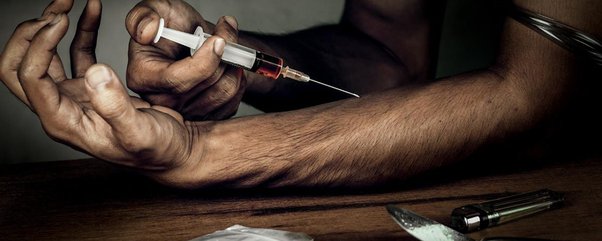
My father disappeared from the scene while my mom was pregnant. After my mom’s divorce from my step-father, I went to live with my grandparents on a small farm in Thermal CA. My uncle lived in the other house. There was a constant parade of counter-cultural relics passing through the ranch. As a kid I might be throwing a football with a Hare Krishna one day, and getting a boxing lesson from an outlaw biker the next. Once my uncle took me to a nearby farm where a bunch of his hippie friends lived. I was about 12 or 13 and was sent out to help pick tomatoes. Living on a farm I had done farm work before, but that day was special because I was picking tomatoes with topless hippie girls.

Kind of like this except fewer guys and the girls were topless.
He had been married several times, and spent 20 years with a woman he met in San Francisco in the early 70s. They had two kids together, but didn’t marry because that would have cost her AFDC benefits.
His drug use lead to drug trafficking and by the late 70s/early 80s my uncle had evolved into a full-on hippie-outlaw. He trafficked hard drugs and committed other crimes. The summer before my 9th grade I was working for him on dry-wall taping job. One of his biker buddies showed up 2 of the least attractive biker gals I’d ever seen. They were all bad skin and bad tattoos. “Today’s the day you lose your virginity,” he said pointing at a gal who looked like an inked up version of Calisto from X-Men comics.

This was not as appealing as the topless hippie chicks picking tomatoes.
He showed up at my mom’s apartment around 4AM the next morning. After partying the afternoon away with the gals I avoided losing my innocence to, he stole some type of commercial vehicle, which he sold down in Mexico.
In the 1980s, he was arrested for narcotics trafficking. The police raided the house and arrested his “ol’ lady” and a couple of his kids. He wasn’t there. The DA had a witness against him, but that witness “disappeared.” He would eventually plea to a lesser charge in exchange for charges being dropped against his “ol’ lady” and sons. He serve a short prison sentence at Soledad.
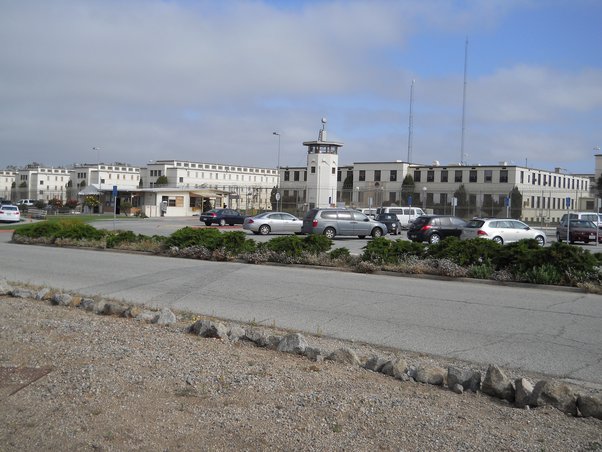
When he came out of prison in 1988, he was healthier than I’d ever seen him before. A couple years of structure, nutrition and daily workouts in the weight pile had done wonders for him. While in prison, he shared a cell with a minor music celebrity. This musician wanted to purchase some of my uncle’s songs. But those deals fell through.
By that time the family farm was a distant memory. My uncle was gifted a house from his father, all he needed to do was pay the monthly mortgage payments which were only a few hundred dollars a month. But as he fell back into drug addiction he lost the house his “ol’ lady” had kept afloat while he was in prison.

After losing the roof over their head, the “ol lady” who stood by him through prison stints and infidelity decided she had enough. She went to live with her mom and became a home-healthcare working. The state of California paid her to take care of her own mother.
By the 2010s, my uncle was living with one of his sons at a hotel on Indio Blvd, a street made famous when Reverend Jimmy Swaggart got caught there with a hooker.
The hotel he lived in was next to the rescue mission. He was living on disability.
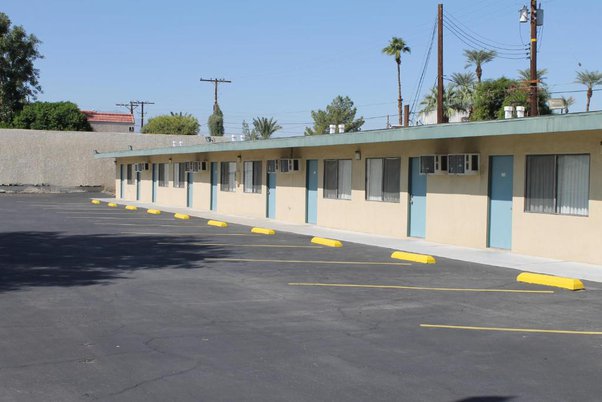
He had tried drug rehab a couple times but always fell back into his old habits. His son was employed by CA as a home healthcare worker…taking care of his father. My cousin was basically paid to stay home smoking dope with my uncle and play video games.
He fell ill. My cousin told me that his “guts exploded.” and he died in his hotel room next to the rescue mission.
Mrs. Bellows’ Benefit Ball | I Dream Of Jeannie
Enjoy.
Solomon Islands rejects ‘inappropriate’ Australian election offer
Duh! Sure let the nation that has been dogging you and insulting you be in control of your elections! How stupid do you think the rest of the world is?
The Solomon Islands has rejected an offer by Australia to finance the country’s upcoming election, saying the timing of the public release of the overture was “inappropriate” and accused Canberra of meddling in domestic affairs.
The Pacific island’s government said in a statement on Tuesday that it appreciated the offer from Australia, which followed Solomon’s Prime Minister Manasseh Sogavare statement that the Pacific island nation could not afford to fund the Pacific Games and an election in the same year.
From HERE
Why is China trying to recolonize Africa?
This sir is Mr. Zhang Zhanping (张展平). He went to Zambia to start a honey business.

All other foreign investors before him took local honey as raw material, exported to Europe and earned huge profits, but gave local suppliers very low price.
On the contrary, Mr. Zhang established a local brand to promote the unique and excellent characteristics of local honey, enhanced the value of the product. The final result is, the income of not only his employees, but also the whole thousands of employees in the local honey industry has increased significantly.
His employees’ comments: “Even one day he leaves, his factory will be left, as well as technology, we can go on by ourselves……”
Recolonize? Reshape? Revolution? Revival?
Nothing but poor narratives.
Supplement:
Frankly, this question itself is obviously an example of propaganda, so I didn’t take it seriously.
But this answer has drawn quite a bit of attention, totally out of my expectation.
Quite a few people have pointed out that one single case can’t represent anything, of course I understand. All I did on this question was just to mock a common trick often used by the western propaganda machine.
Someone tells me this is named as marginal narratives. I’m glad some can see through this, so next time you watch or read some reports on CNN, BBC, New York Times, Washington Post……and so on, about China, or Iran, or Russia, or Cuba, or North Korea……I hope you still can stretch your adorable smart, and raise same doubt. If you truly can, all I did will be worthy.
Lucy
This is Lucy. I found her when walking my dogs when I lived in a very rural area in the countryside. She was only about 5 weeks old so how could you resist!! She is 5 years old now and is and always has been the sweetest and most affectionate cat I’ve ever had. She’s so mindful of her claws and never scratches. My other cat adopted her as her baby and tried to carry her around by her neck and licking her clean.

Do Westerners who bash China for helping Africa (yes helping) know how actual Africans view them and their ‘helping’?
I am Tanzanian.
China is not helping Africa. China is trading with Africa, and sometimes investing in Africa.
“Helping” is what Westerners pretend to do. But we know what their game plan actually is. It’s far from helping.
Westerners donate inconsequential amounts to fund things like “democracy”, “human rights”, “women empowerment”, “education”, “health”, “wars” etc. Things which have little impact to development, and are not sustainable (ie they don’t make money) so they’ll help Westerners create the myth of perpetual Africa aid.
The real deal in terms of economic development is industrialization, and not human rights, democracy, women empowerment, etc. Little things like those take care of themselves once there’s industrialization and the money is flowing in.
Western aid is mainly two things:
- (If given directly to govt) A bribe to buy influence and certain leeways in Western extraction of Africa wealth.
- (If done by NGO’s and charities) just a way for Westerners to milk their fellows in the West to fund their lavish lifestyles.
The West is also very big on war mongering, assassination of African leaders (you are Belgian so you should know what you did to Patrice Lumumba), meddling in African politics, creating wars, etc. The West generally has ill-will toward Africa and thinks of Africa as colonial land to date.
China doesn’t do aid.
It does things like this Kilamba New Town in Luanda (pictured below) whereby a new housing development was built in exchange for oil. This is a much better deal that paying for oil with cash as the cash is often squandered and very little goes into building the country.
This is trade.
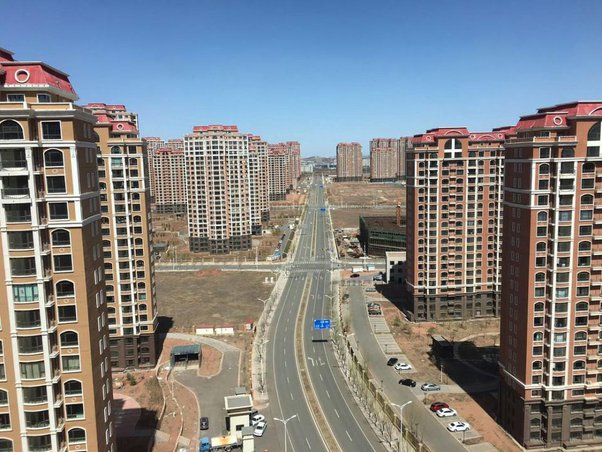
Building lots and lots of roads, railways, and bridges. China often offers the best value for money in such grand public works meaning they do quality work at low cost.
Examples:
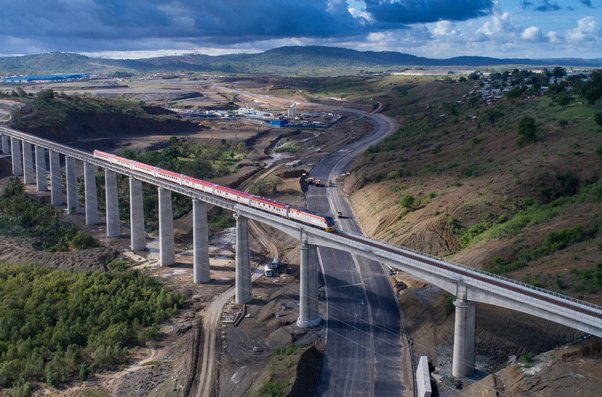
This is trade.
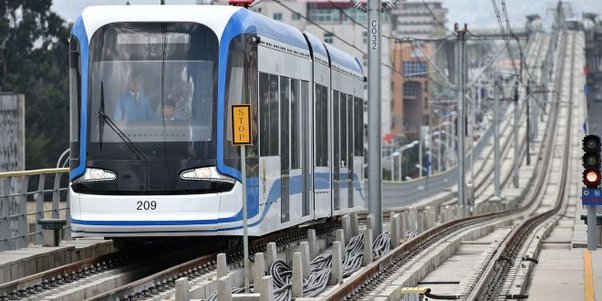
Things like these are never associated with The West in Africa. They are associated with China. They help a lot in creating the good image of China in Africa.
And the kicker of it all, the govt of China doesn’t have a colonial mindset. It never tells African countries how to run our countries. They simply look for opportunities and trade.
Now don’t mistake this as “Africa depends on China”. No. We understand development is our own task. Understand this only in terms of geopolitics as each country in the world is involved in geopolitics.
Also many Westerners come off as extremely phony in how they talk about China relations with African countries, because they seems to be unaware on how their own countries are connected to China and how much trade they do with China.
It’s extremely phony that Westerners don’t see that. For instance USA seems not to notice they have more Chinese people in their country than all the Chinese people in all 54 African countries. They seem not to notice that they have Chinatowns and “eating Chinese” has become a TV trope in their TV shows.
It’s phoney that to the West “China in the West” is ok, but “China in Africa” is bad.
Rufus story
On my way home from a 12 hour day of cutting lawns, I seen this gentleman, I have no clue who he is to this day. But I said no way was I gonna let this guy tackle this on his own. So I turned around and went back and unloaded my mower and drove across the street and ask the gentleman if I could help.

His eyes lit up and I took that as a yes. I ran down, jumped on my mower and went to work. As I’m cutting the lawn I look over and see the gentleman hunched over his wife, resting his head on her shoulder.
So I get it knocked out in no time. I give them a thumbs up and proceeded to load my mower up. The wife makes her way over before I could leave. She was so thankful! Their riding mower broke down and her husband has been mowing their big lawn with a push mower. It only took 15 mins of my time. I changed their life, for a small moment.
I hope someone reads this and feels like doing something good for someone tomorrow. I’m grateful to be where I’m at and I’m thankful for the people that help me get here.
Is living in China a pleasure or a torment?
I lived in Shanghai for three years and worked at a university. I lived in an average apartment, in an average area of town, and took the metro to work.
I would say it was a pleasure.
Life in Shanghai is inspiring, friendly, and rewarding. I also regularly visited Beijing and Wuxi, which had a lot to offer, as well. What makes China a pleasure, in my opinion, is the following:
- amazing food, and it is everywhere, and you will have the time to eat it;
- the Chinese are great fun; energetic, witty, resourceful, and quick to share a laugh or a smile; I’ve had a blast with the people there! Even ended up taking one home with me, first to England, then on to Sweden.
- interesting expats everywhere; you will meet much more interesting people in China than you could ever hope to meet at home; westerners who come to China are usually highly qualified people with unusual views, and it is great to hang out with them, and they will want to;
- the cities are mindblowing; huge, glitzy, full of opportunity and strange things that will entertain you endlessly;
- you can actually be someone in China; everything grows so fast, before you know it, you are the managing director of something, with your own team; China “made me,” I can say that for certain, because I was given opportunities there I never would have had at home.
I have lived in nine countries, and came to China from New Zealand. I had no expectations at the time, but was pleasantly surprised just the same.
Here some images from my very normal, Shanghai life that is quite attainable also by the Chinese, not just by westerners posted there on a contract (my apartment could have been rented by a normal, Chinese family, too).
My apartment:
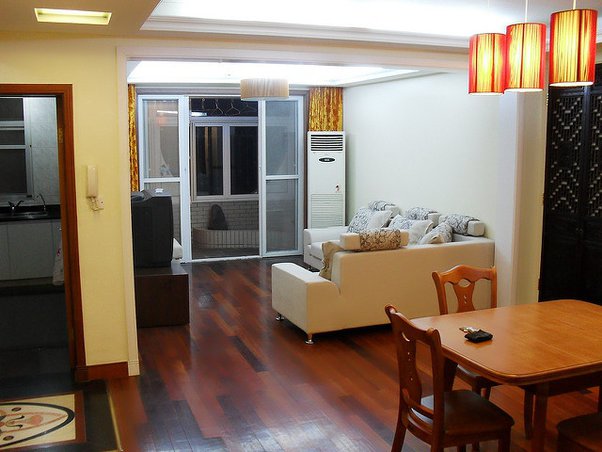
The entrance door to my apartment building:
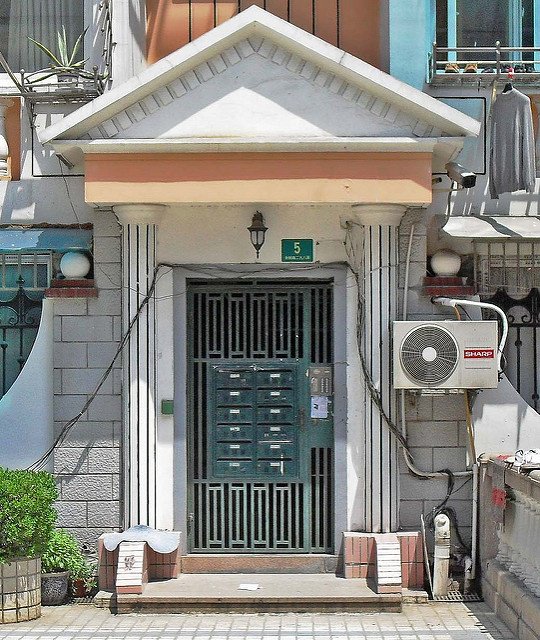
Where I worked:
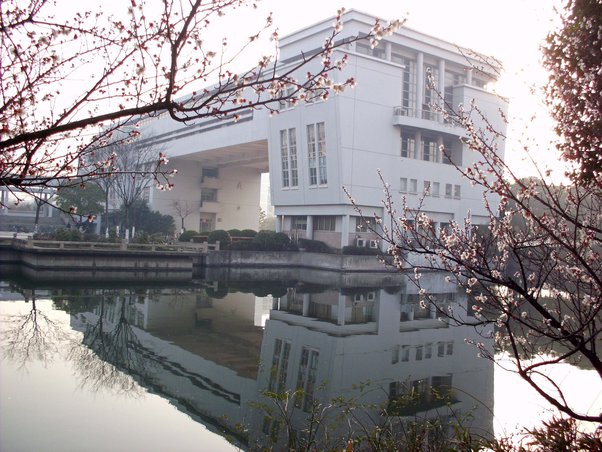
Traffic:
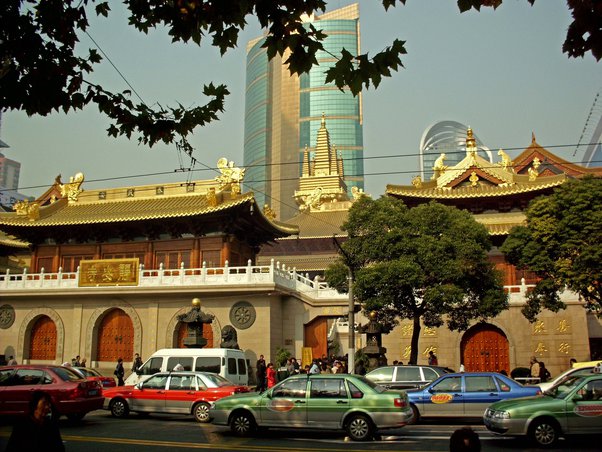
A typical cafe:
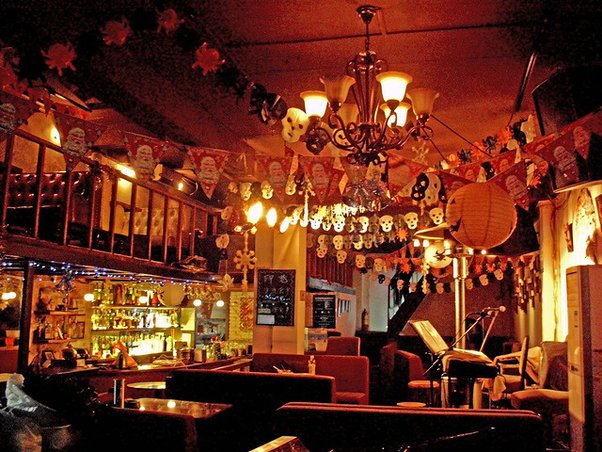
My favourite meal, Beijing duck, hot and sour soup, cauliflower and bacon:
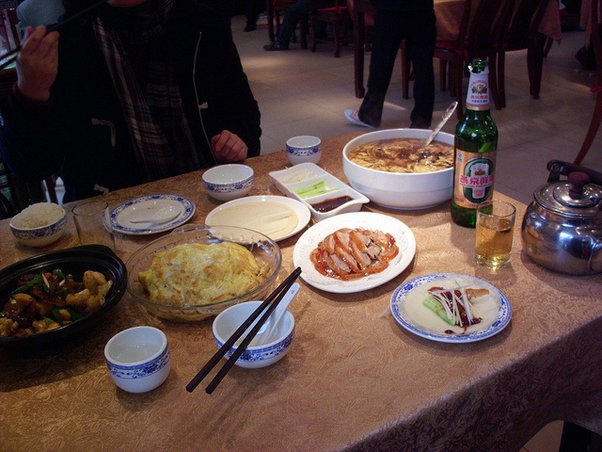
Yellow wine (a rice wine with about 12–18% alcohol), a pleasant drink I often enjoyed in the evening:
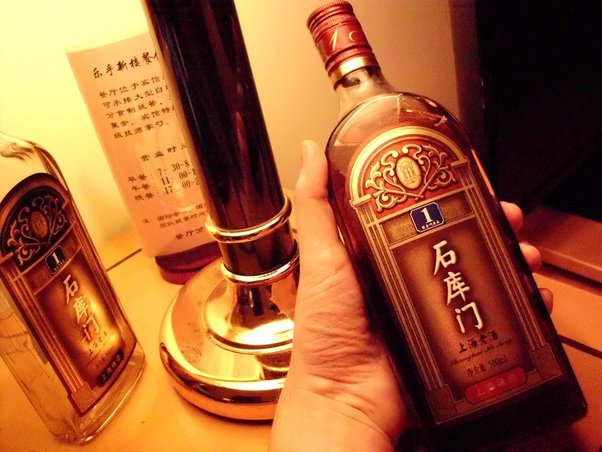
Professor Greg Patton
Professor Greg Patton of the University of Southern California was removed from his post for the horrendous crime of teaching his students a simple Chinese word.

While teaching a communications lecture he spoke of how different cultures use different ‘fillers’ words. In English we use “um”, “uh”, “y’know” etc. He then mentioned that in China they commonly use “na-ge” which translates into “that”.
Predictably several of the students got themselves upset over this and decided the Chinese word “na ge” sounded too much like the dreaded “nigger”. They complained to the university. The university, of course, immediately capitulated and convinced Patton to step down.
The university then released this statement:
"It is simply unacceptable for the faculty to use words in class that can marginalize, hurt and harm the psychological safety of our students."
In the middle of a lecture on communication, a professor explained how the Chinese use a particular Chinese word that some students decided sounded like an English word they find offensive, and got the professor sacked.
That’s PC gone too far for my liking.
China’s War On Pollution 2021 | 中国对抗污染
Do you think the Chinese president, Mr. Xi, is a good leader?
Xi Jinping is worth more than the combined total of Trump, Trudeau, Bush, Mitt Romney, Doug Ford, Boris Johnson, Scott Morrison, Shinzo Abe, Rajiv Gandhi, Silvio Berlusconi, and every other lavishly rich democratic leader who was born with a silver spoon in his mouth, never had to do a day’s work in his life, never had to prove his abilities as an ordinary citizen or prove his merits as a leader even minorly through objective, competitive metrics, and never had to rise up the ranks of a meritocracy.
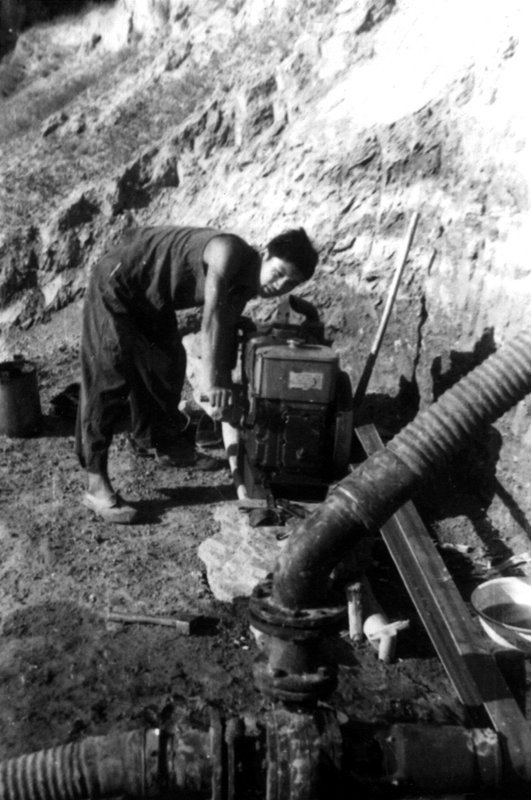
All these leaders had to do was sail through the “cursus honorum” prepared for them by their families, as though they were crown princes getting groomed for the throne.
Usually this involves effortless admission into a prestigious university that their fathers and grandfathers studied at and donate to, graduation with lacklustre marks, and automatic employment in one lucrative, high—profile PR—like job after another, tripping on millions of dollars as they walk and erecting their political brand along the way.
A Western politician who is only worth a few million dollars is a pauper among his peers.
Rajiv Gandhi repeatedly failed his courses at Cambridge where he was “studying” to become an engineer, and later admitted that the reason was that he simply did not care. He was never in the mood to “muck it up” for his exams, as he later admitted. From his teens onward, everyone pretty much begged him to enter politics, because of his surname. He entered politics at 36, running for a seat in parliament that had formerly been occupied by his brother; the seat passed from brother to brother like a feudal estate. Four years later Rajiv became Prime Minister.
What kind of leadership is this? Government by celebrities?
The path of almost every US Senator is very similar. Born into a rich and prominent family, easily admitted into an Ivy League, was a poor student but very social, went into law or business (often the family business), and ran for his first office by his 20s without a record of actually having accomplished anything as a human. And unless he set an old lady on fire or got exposed as a paedophile, his political ascendance was assured. It’s kind of like your next 10 million dollars being easier to make than your first; after your first big election win, the rest practically land in your lap. You’re a brand, famous for being famous.
The exception is a fellow like Modi or Bolsonaro — from a plebeian background, but similarly unaccomplished and unproven. Instead of riches, he is enabled by the gift of having a big mouth and understanding the masses and knowing how to manipulate them. He is a masterful charlatan, actor and illusionist. Trump was so unique because he had both advantages.
This isn’t government “of the people” or “by the people.” It’s plutocracy and oligarchy, except when interrupted by mobocracy.
And once you observe what section of society is most loyally served by these politicians — even the reason they wage war so often — you learn that it’s not really “for the people” either.
Abe Lincoln’s words are dead and ring hollow.
Yeah, the more I see Western—style democracy in action, the more I fail to see the consecrated “of the people,” “by the people” or “for the people” part.
Japan’s leading statesmen are the grandsons of its leading statesmen from World War II and even earlier — some since the Meiji Restoration. You understand this? The same families in power for almost two centuries. This is called democracy, but in practice it’s rule by a tiny class of hereditary nobles. The US is almost the same.
A right—thinking man ought to respond with contempt when another man who has never sweated from his brow or proven his abilities is given leadership over him. For some reason, this is not the reaction from most populations.
It would very much be the reaction in China. Xi Jinping is respected and entrusted with leadership not because of wealth, birthright, privilege, a big mouth or the ability to whip the masses into a frenzy, but because of his history.
His proven track record as a man and ordinary citizen, a labourer, a leader of villages and communities who rolled up his sleeves like any peasant, climbing slowly up the ranks according to austere party officials who judged his performance, not according to masses who fell in love with his illusion.
When you really think about it, it’s illogical not to have more respect for the manager of any McDonald’s who got to his position ten years after peeling potatoes and scrubbing toilets, than for the leaders of Western—democratic countries who just had to come out of the right vagina or learn how to speak the loudest BS.
Rufus Story
“Rural coffee county Alabama. This teenager was filling up his Mustang when the older gentleman pulled up with his can for the mower and was patiently waiting.
The teenager noticed, pulled the nozzle out and said “sir will you please let me see your can?” He filled it up as the older gentleman objected but settled in to a story. When the kid finished, he put the nozzle back into his car to finish filling up his own.
He refused to take money from the gentleman and wished him a wonderful day. They are all over this country and they come in many shapes and colors. Don’t denigrate his generation. Train them to be like this. I can assure you, he was raised to say sir and ma’am. As he pulled out onto the blacktop he lit the tires up on his red stallion, smiling the whole time….. and so was I.”

The definitive end of the Unipolar Era, 1992-2022
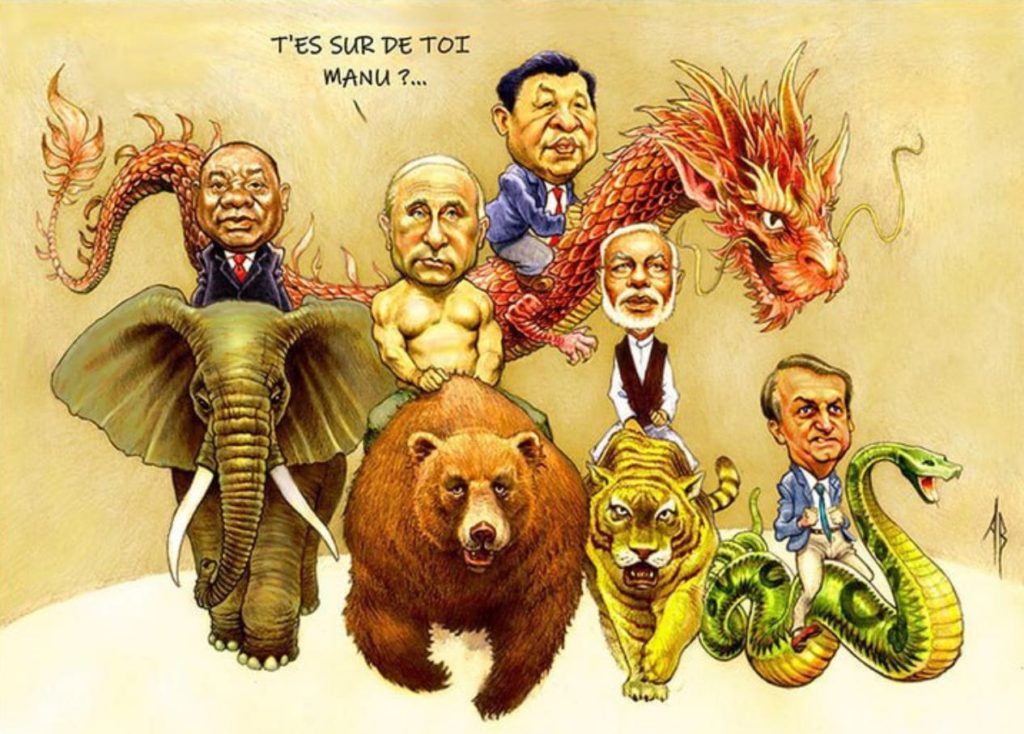
Was the English comedian Benny Hill as creepy in real life as he was on his TV show?
Benny Hills , actual name was: Alfred Hawthorne Hill)
He sang “ The fastest milk man in the west!

He ,made people laugh,he was extremely creative,and had so many characters in his act!
If anyone got anything negative to say about the guy,no one’s listing , brilliant man!
Rip Benny!!
Does China produce enough food to feed its populace or does it have to import food?
Also take note why the neocon effort to induce famine in 2017 - 2018 failed. -MM
Seeing is believing. Open your Google Earth and have a look at what is really going on in China from above. Western media won’t normally tell you about this.
I will guide you through and point you where to look at.
Here are the coordinates:
Location 1: Ningde Bay, Fujian, China (26°43’02.8″N 119°57’45.2″E)
Our first destination is the coastal area in Fujian province.
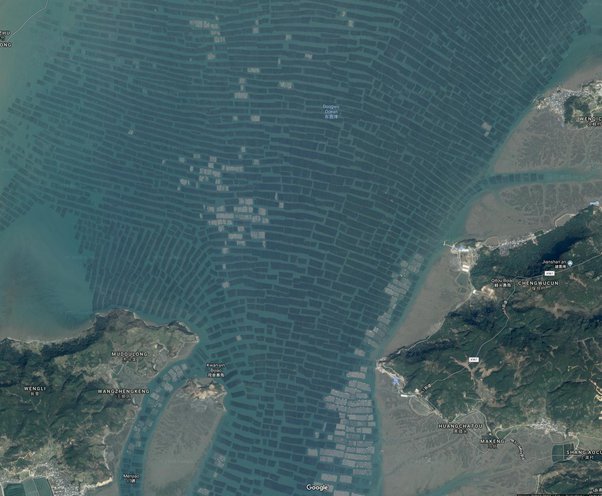
If we zoom in, we can find millions of floating houses and cages on the sea surface.

If you look around the coastline from Zhejiang province to Guangdong province along the 1000 miles, you can see those floating cages are virtually “everywhere”.
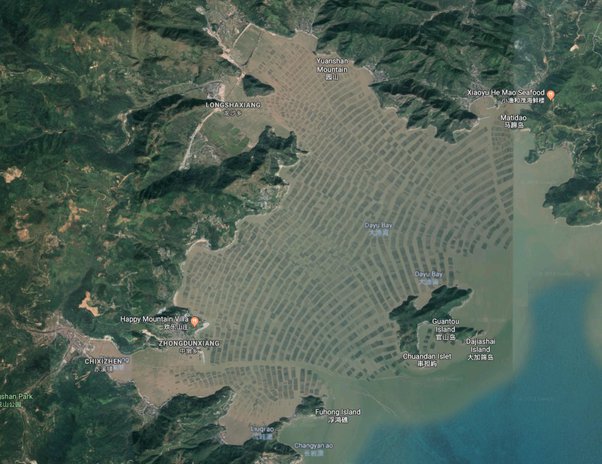
What are those? They are actually Chinese “seafood farms”.
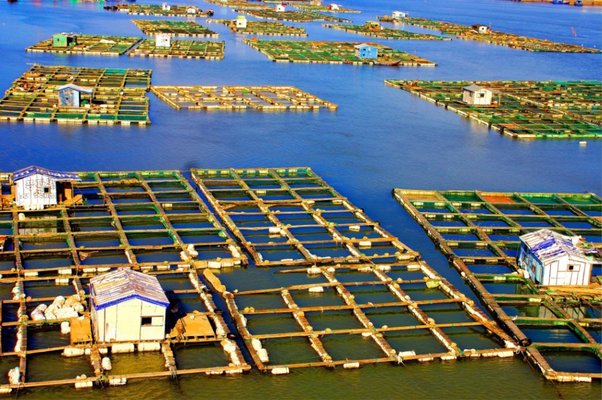
Instead of going out to the oceans and catching wild seafood, why not stay in the same place and raise your own seafood? And you can actually make more money with much less effort from raising fish, shrimps, crabs, lobsters, clams, etc.
It is not just sea or ocean waters that are being farmed, Chinese farmers find any possible open water such as reservoirs, rivers, lakes for farming their seafood/freshwater food.
Imagine each of the cages contains tens of fishes and crabs. That’s A LOT of FISH!
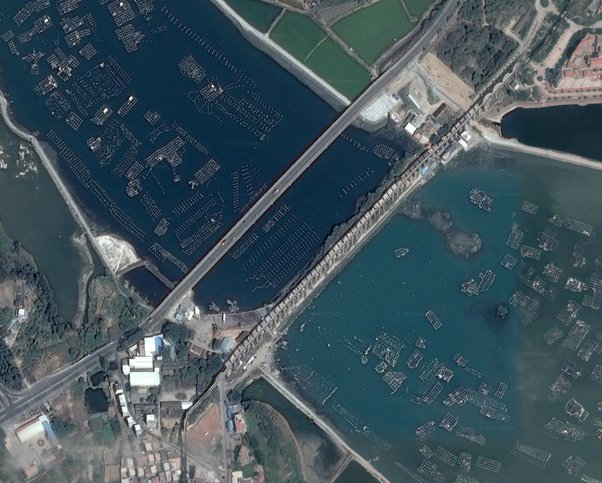
So how much seafood does China consume?
It is estimated that the global demand for seafood consumption is 143.8 million tonnes per year and China alone has the largest seafood consumption (65 million tonnes, 45% of global consumption), followed by the European Union (13 million tonnes), Japan (7.4 million tonnes), the United States (7.1 million tonnes) and India (4.8 million tonnes). (Source: EU SCIENCE HUB)
As we know, both China and India have a similar population but China consumes 12 times more seafood than India, despite the fact that India is in a better geographical position surrounded by warmer oceans in a tropical fishing-rich region.
Among the 65 million tonnes of seafood consumed in China, only 15 million tonnes are caught from the wild, the rest of 50 million tonnes are all raised by aquaculture “farming”. In contrast, 90% of Japanese seafood consumption is from wild catch. Thanks to seafood farming, normal Chinese families can afford cheap seafood in their daily meal. This is a typical family get-together dinner settings: You can see lots of them are seafood!
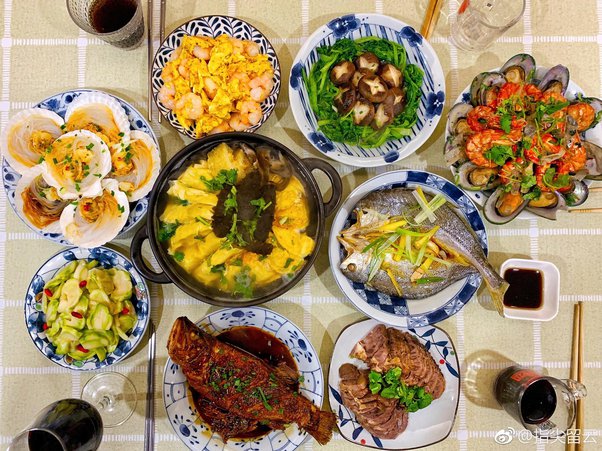
Location 2: Nanxun, Huzhou, Zhejiang, China (30°46’14.5″N 120°09’02.9″E)
Our next destination is the vast flood plain of between the Yangtze River, Taihu Lake, and Qiantang River. Thanks to the abundance of fresh water carrying nutrients from the river upstream, this area is so productive that it has raised over 100 million people here. And it is one of the most densely populated areas of China. This area is very similar to the flood plains in Bangladesh, West Bengal in India, Saigon in Vietnam etc.
What have the Chinese done differently compared to other densely populated flooded plains in India and Bangladesh?
Instead of growing rice, the Chinese have been growing a variety of “water food” that can sell at higher prices and makes them become richer than if they were growing rice. If you zoom in, you will find millions of fish ponds instead of rice fields. Besides the fish ponds, you might identify lots of green trees grown around them.
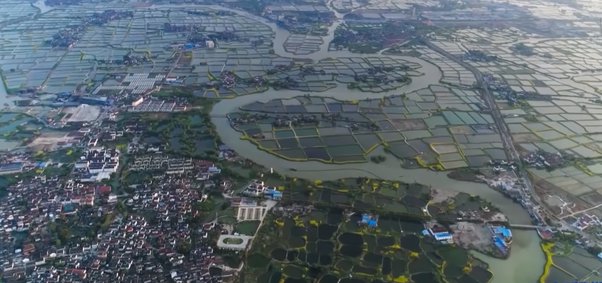
These trees are mulberry trees used for silkworm farming. Over the past two thousand years, the Chinese have developed many sophisticated and sustainable agriculture ecosystems around these areas. One most famous eco-cycle is the fish-mulberry tree-silk cycle as shown in the following graph:

Chinese farmers have been exploiting the ecosystem in fish, silk farming for thousands of years without knowing the concept of “sustainable development”. Nowadays, it is evolved into multiple cycles of “recycling” on the same land:
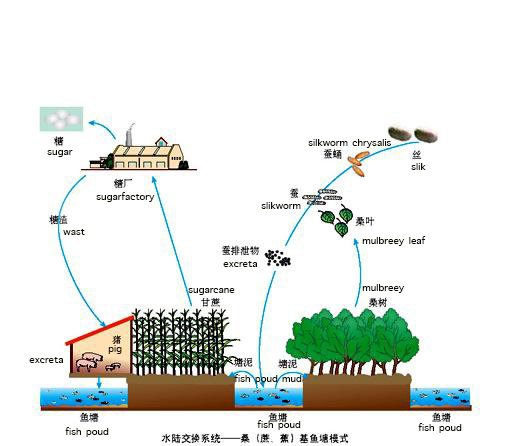
However, in order to raise more fish in the ponds, you need an aerator that pumps air into the water, otherwise, the fishes would not have enough oxygen to breathe. In the following picture, the aerator is the white dot in the centre of each pond.
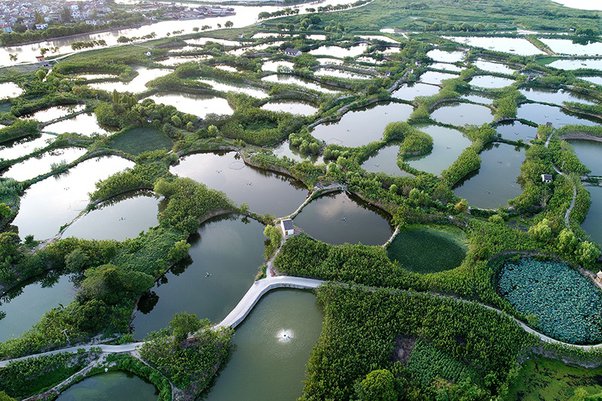
Having an aerator requires every fish pond to be connected to electricity. How to generate electricity for the aerators? Yes, you are right: have solar panels.
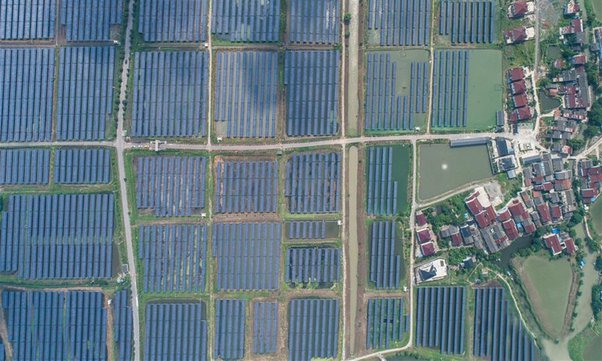
From Google Earth, you can see that solar panel fish ponds are already taking over some of the traditional mulberry fish ponds in China. Some of the areas in Huzhou area have already installed solar panels.
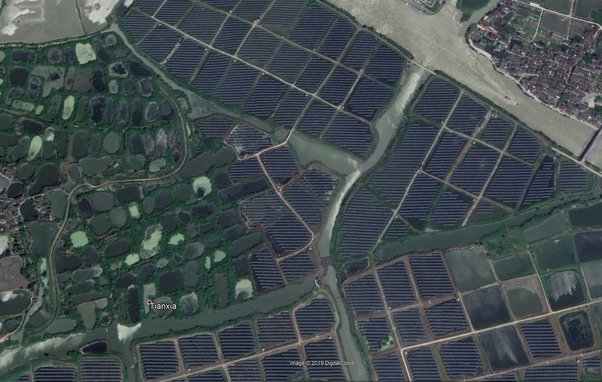
Above picture: The left is the traditional mulberry fish ponds. The right is the latest solar power fish ponds.
Local fishermen and farmers are actually forced to learn the latest solar technology and sustainable techniques provided by professionals from the local Chinese government.
Why are the local Chinese governments so eager to promote high tech to the local farmers? In order for an official to gain promotion to the next rank, he or she has to demonstrate their “government performance”. Solar panel fish ponds is one of the best indicators for “promotion” as it fits well in the sustainable development initiative.
From this, you might understand why China has dominated the world’s silk production (84%), and freshwater fish production (66%) and solar energy generation (25.8%). In the Zhejiang, Jiangsu area, rural people eat fish almost every day. Some say that’s why people from these regions are more clever than other regions of China.
Eco-cycle option 2: lotus root – fish
In some fish ponds, you can also grow other kinds of vegetables while raising fish. One of the most widely grown vegetables is the lotus root. China lotus root production is 11 million tonnes which accounts for 90% of world production and 60% of the world export. Not only Chinese people like to eat them, but most of the lotus root production is exported to Korea, Japan, and Vietnam.
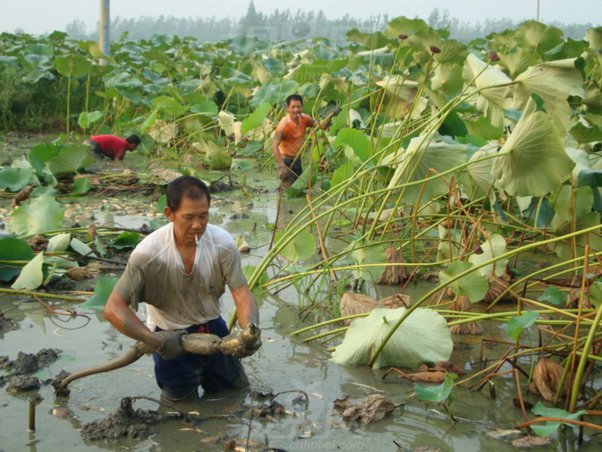
Lotus roots are one of my favourite vegetables too, I hope China can promote this delicious root for the rest of the world to enjoy as well.

Eco-cycle option 3: canola oil – bee- fish & crab
You can also grow rapeseed using the same principle. Instead of using fertilizers, at each winter, Chinese farmers dig the “nutrient mud” from the bottom of the water and stack on the bank. And then they grow different plants such as rapeseeds or taros on the mud. After thousands of years of continuous cultivation, the field has become something like this:
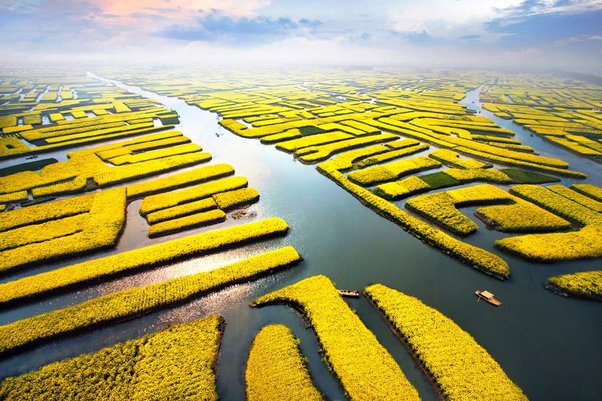
Location: Duotian(垛田镇), Xinghua, Jiangsu, China 32°56’51.9″N 119°51’50.4″E
There are no roads. You can only navigate around using boats. Of course, that is why China is also the leading world producer of rapeseed oil (22% of global production).
Not to mention the massive beekeeping industry that thrived on the rape flowers in China, China takes over 30% of the global honey production.
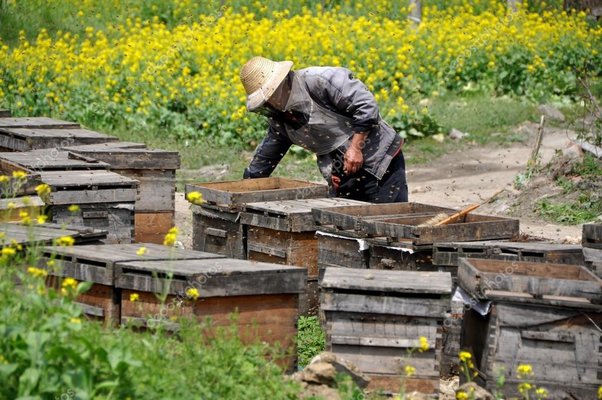
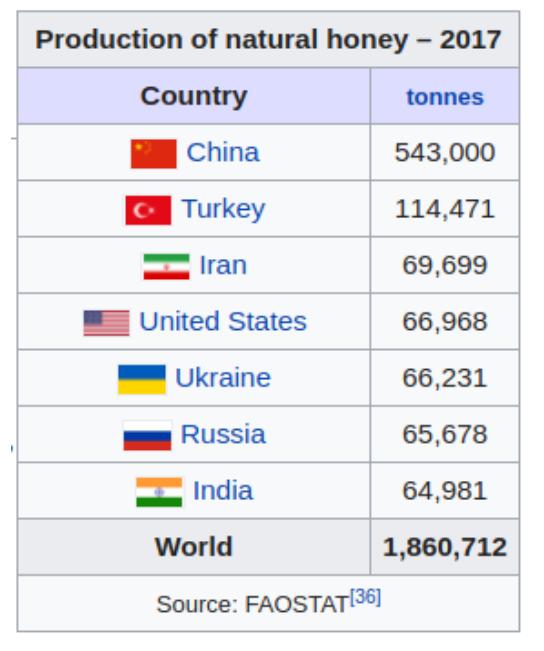
Actually, one-third of the honey consumed in the US are directly or indirectly from China. To avoid tariffs from the US, Chinese honey exporters would first export their honey to India, Philippines and Malaysia. Then they change labels and alter them to domestic production and sell them to the US. I’m sure this happens to other products too.
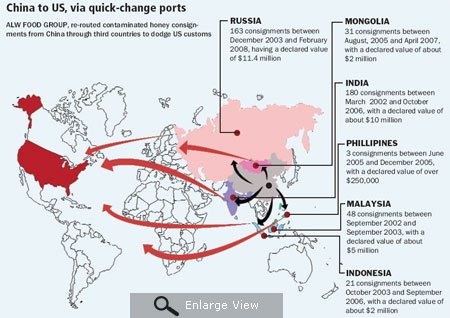
Besides honey, this area is also where the most famous Chinese mitten crabs are produced. They can sell at $60 per kilo, therefore only the middle-class Chinese can afford this.

Location 3: Shouguang, Shandong, China (36°44’15.9″N 118°44’14.7″E)
Our third destination is the great plain area in Shandong province.
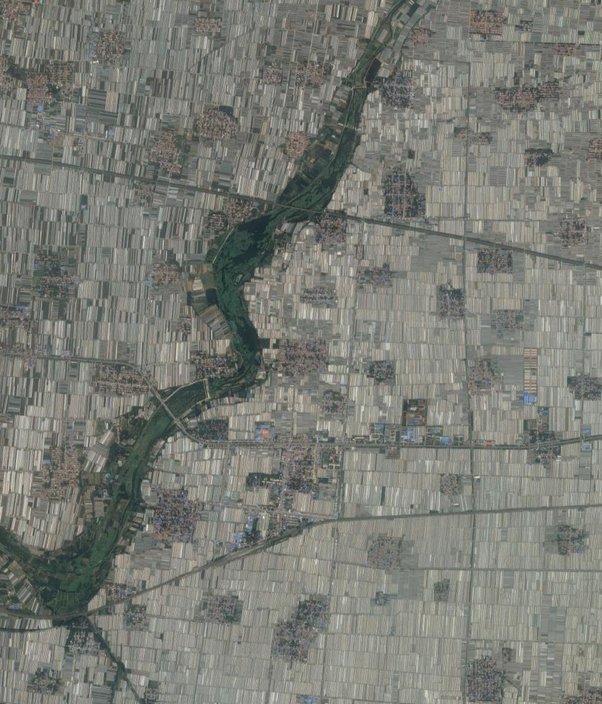
If we zoom in, we can find millions of reflecting “shiny” houses on the plain area. Try looking around, it is “everywhere”.
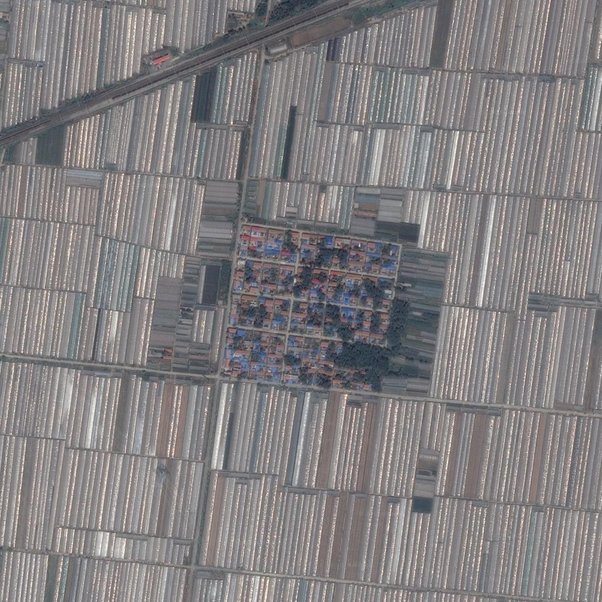
What are those? They are greenhouses designed to provide regulated and controlled conditions such as temperatures and humidity for vegetables and fruits to grow.
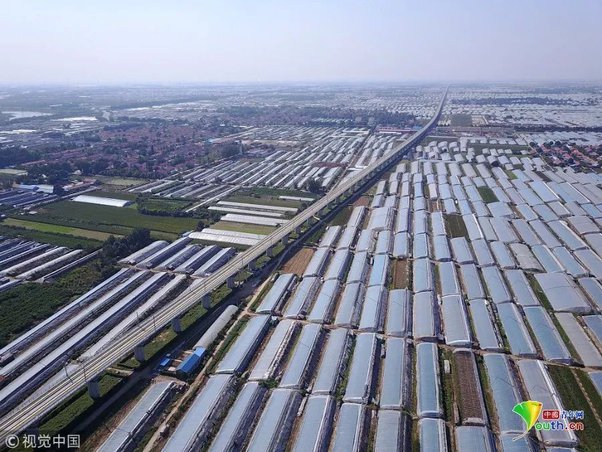
In the greenhouse, you can grow all kinds of different vegetables and fruits several times per year regardless of the time of the year. That means you can get several times more vegetable and fruit yield compared to a normal field.
For example, you need at least 52 days to grow lettuce from seeds until you can harvest them in a greenhouse. That means you can grow 7 times each year. That is 7x efficiency.

Therefore greenhouses can significantly improve agriculture output in a limited space, which sounds perfect to the Chinese. Eager for promotion, local Chinese government officials in Northern China have therefore forced their constituency —the local farmers to install greenhouses with loans from the “Chinese Rural Cooperative Bank”.
What’s worse, they also forced them to install IoT based surveillance system in their greenhouses. Farmers are forced to be taught in a “reeducation camp” to use their mobile phones to monitor the status in the greenhouse including CO2, light strength, soil temperature, etc.

As a result, according to the Food and Agriculture Organization of the United Nation, the vegetable and fruit production and consumption of China is around 700 million tonnes, which is 40% of the world consumption. Compared to India (180 million), China achieved 3.8x the amount of vegetable and fruit production, despite most of the population in India claim to be vegetarians, and despite the fact that the arable land in China is less than India. The secret key is the greenhouse.
List of largest producing countries of agricultural commodities – Wikipedia
Thanks to greenhouses, Chinese people can enjoy cheaper and a bigger variety of vegetables than any other country in the world all year round. You can check Wikipedia, basically, China tops the chart in almost every kind of non-tropical vegetable production, far outpacing second place. There are vegetables that are not ranked because they are only specific to East Asia, such as the “garlic chives” (韭菜).
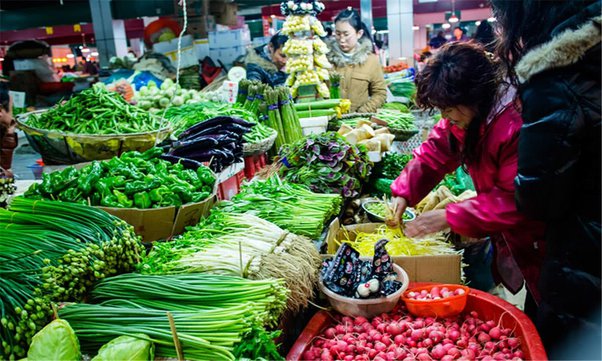
Similarly, for fruit production, China tops the global chart in almost every kind of non-tropical fruit production, far outpacing second place as well.
I was once pranked and called as “racist” when I invited a black friend over for a summer BBQ with lots of watermelons. I proved my innocence by showing him these statistics:
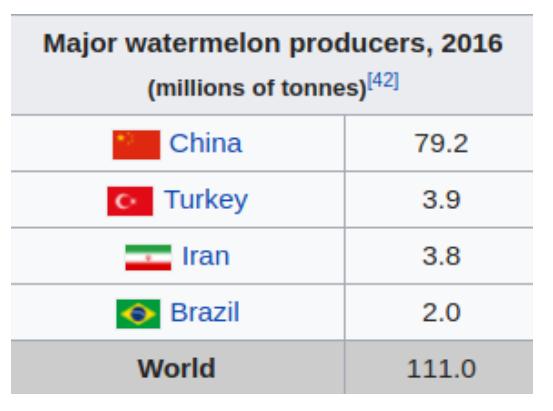
In Japan, a watermelon typically costs 2000 yen ($18) and in China, you can afford a much larger watermelon just in 10RMB ($1.5). And watermelons in China are sweeter if they’re grown in Xinjiang. If you love watermelons or any other melons, come to China, especially Kumul in Xinjiang.
Location 4: Lhasa, Tibet, China (29°41’52.3″N 91°09’18.6″E)
Our fourth destination is also about greenhouses but in Tibet. Use your Google Earth and navigate to any town in Tibet. You will always find greenhouses.
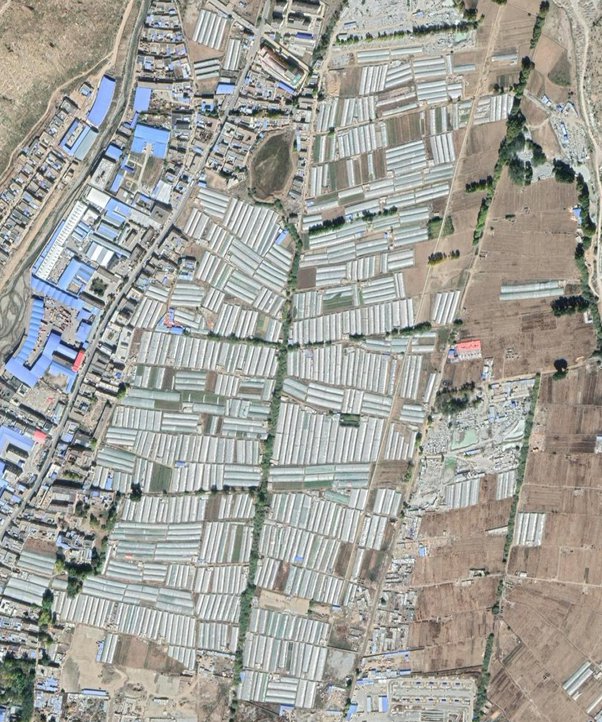
I mean, the Chinese government has also forced Tibetans to build a massive amount of greenhouses on the Tibetan plateau. Those Tibetans have no time to go to temples for worshipping any more, instead, they have to work in the greenhouses taking care of tomatoes. This is why Dalai Lama is not so happy to hear this.
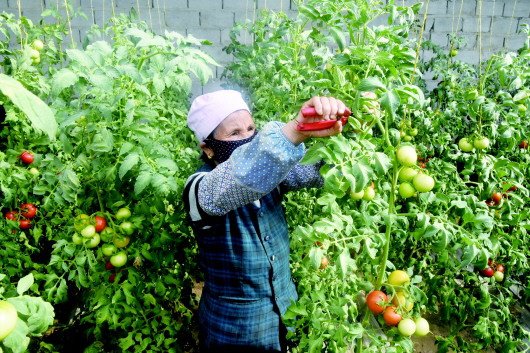
As a result, the average vegetable price in Tibet has reduced by 90% over the past decade and they don’t have to import vegetables from nearby provinces anymore. Most of the Tibetans can finally afford to eat watermelons. Who doesn’t like eating watermelons?
You know that most Tibetans historically only eat yak meat, milk, cheese, and bread? They couldn’t grow anything in such a harsh climate. Only monks could have the luxury to eat vegetables. Now it is the solid proof that the Chinese government didn’t just destroy temples in Tibetan culture but helped them eat vegetables and fruits.
Location 5: Kokdala, Ili, Xinjiang, China 43°43’51.2″N 80°35’21.5″E.
Kokdala is a city in northern Xinjiang, China, bordering Kazakhstan’s Almaty Region to the west. And here is the satellite image of the border between China and Kazakhstan.
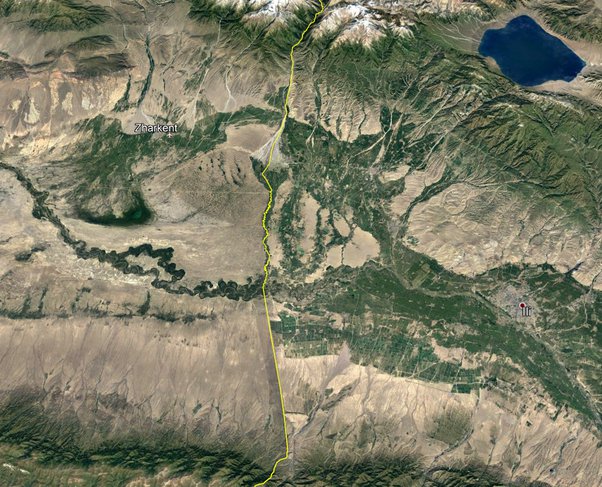
And you can clearly see there are more green farms on the Chinese side. On Kazakhstan’s side, there is nothing but barren lands.
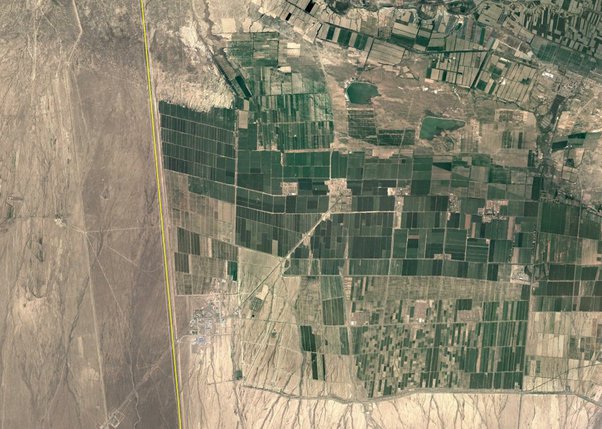
And actually, these lands are just wasted land as their soils are too acid and there is limited water to grow any food. You can only count on the water from the melting glaciers in the surrounding mountains. For people in Kazakhstan, it is too expensive to grow and they don’t have a big market to sell their products. That’s why those Kazakhs in Kazakhstan decided not to cultivate on those lands.
On the Chinese side, all the barren lands are cultivated by the special division of the Chinese government: XPCC Xinjiang Production and Construction Corps – Wikipedia
. This is a state enterprise with a military background. XPCC has amassed 2.6 million employees and farmers including Uyghurs and Hans and operate as a giant organisation. Therefore due to its scale, the cost of operation can be reduced and their market can be directly connected to the whole Chinese market.
Since the past three decades, XPCC has been sending its agriculture professionals to Israel every year to learn Israeli’s most advanced agriculture technology in a similar desert climate. Those Chinese students then returned to China and started cultivating those lands using the latest technology such as drip irrigation etc. Once they found those technologies can actually mature into profits, they would sell some of the newly cultivated lands to local Uyghur, Han, and Kazakhs families or hire them directly in the cooperations.
Some of these Uyghurs, Kazakhs are sent to the reeducation camps and they are forced to learn Mandarin Chinese and the latest drip irrigation techniques to save water and reduce costs. Moreover, each village is assigned with one or more communist party members to guide them through to make sure that they don’t mess up the newly cultivated land.
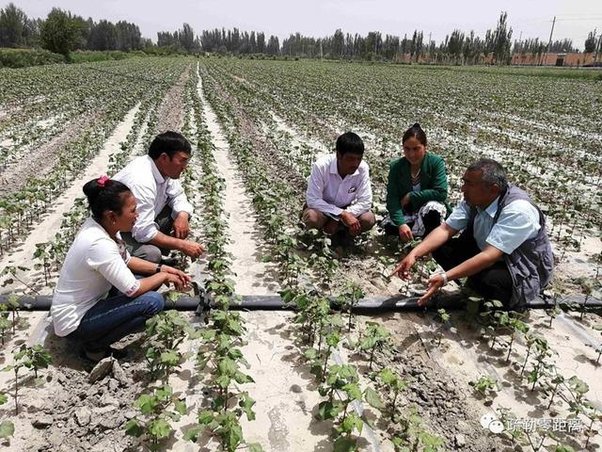
Yes, the drip irrigation technique can significantly reduce water usage and cost. Thanks to the Israeli and domestic Chinese technology, they make the barren land in Xinjiang more and more fertile and productive.

So what are those people growing on the new land?
Tomatoes, chillies, melons, grapes, and cotton. All of them can sell at higher prices than wheat.
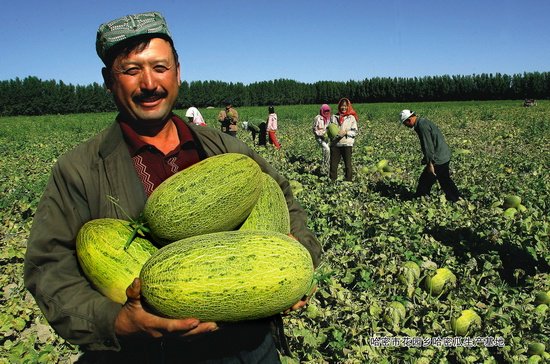
Thanks to the strong sunlight and cold nights in Xinjiang, those products are normally sweeter and tastier, so that they can sell for higher prices to the markets in China and the world. In China, people prefer to buy fruits from Xinjiang than the rest of China because of its great taste and quality.
Actually, agricultural efficiency is so high in Xinjiang that it produces much more than the Chinese market actually needs. Instead of relying on the “free market” causing the prices to drop and hurt those Uyghur farmers, XPCC, as a state enterprise, is pushing to sell those products to the rest of the world at higher prices.
What if the rest of the country doesn’t want to buy the products?
The communist XPCC is relying on China’s “superpower” to force those customers from the rest of the world to buy using some terms and conditions that you can’t refuse. This strategy is learned from the U.S. agricultural business model. This is exactly what the US has been doing. And this is what “state capitalism” is about. Whenever Xi Jinping is visiting a country, he is also in charge of selling those products to the country by signing “free trade” agreement using carrots and “implicit sticks”.
If you are not convinced, let us move to the next location for more proof:
Location 6: Hejing, Bayingol, Xinjiang, China 42°18’36.1″N 86°36’15.4″E
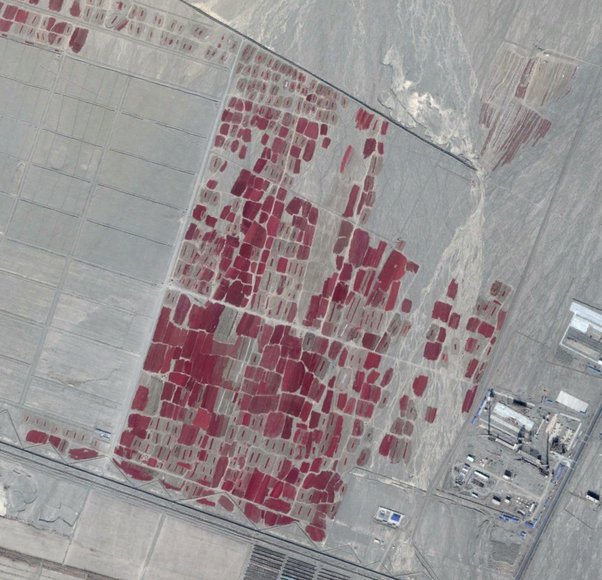
What are those “red” lands in the middle of the desert?
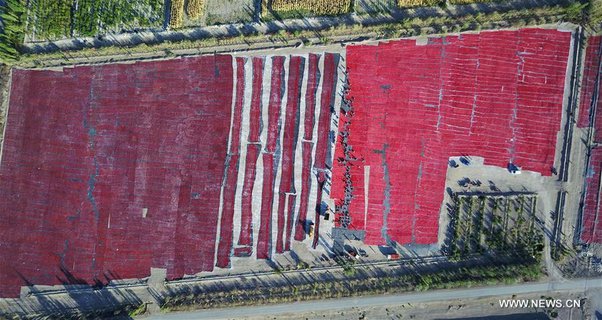
If we zoom in, you can see it is actually the land of “tomatoes” — billions of tomatoes. You can imagine the amount by measuring the total area.
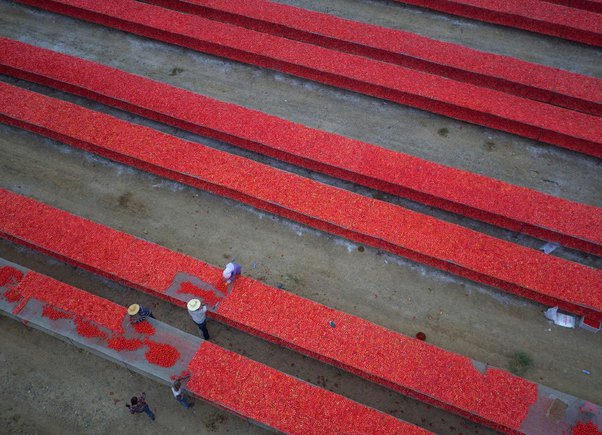
Next time you enjoy Italian spaghetti, Turkish kebab, or spreading Heinz ketchup on your chips, think about the fact that you may be eating tomatoes from Xinjiang.
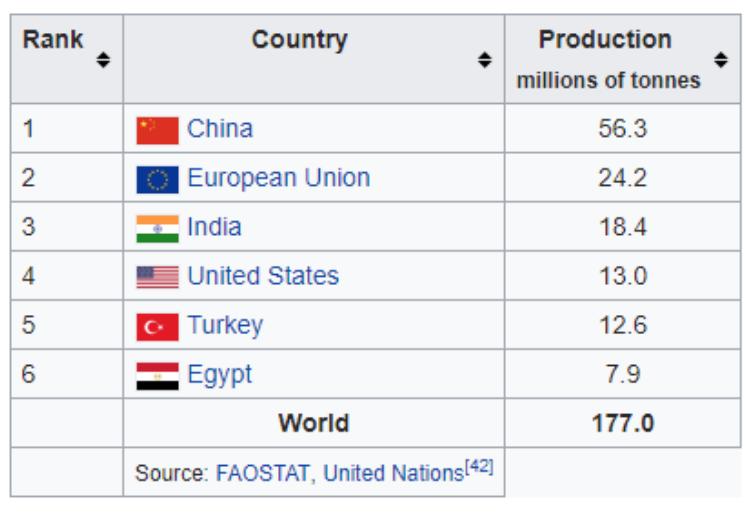
It might not directly say the tomatoes are from Xinjiang. These tomatoes might be first exported to a third world country and then rebranded just as the honey was.
Your Ketchup Probably Came from Xinjiang | Xinjiang: Far West China
China produces 56.3 million tonnes of tomatoes and dominates 1/3 of the world’s tomato exports. Over 14 million are from Xinjiang. You can verify this by looking at the global top ten ketchup companies The World’s Leading Producers of Tomatoes
:
- COFCO Group (China) 2nd
- Xinjiang Chalkis Co. Ltd (China) 3rd
- Fuyuan Agriculture Products Limited (China) 6th
- Heinz (United States) 7th
- Xinjiang Tianye Co., Ltd. (China) 15th
These companies are more or less the redistributors from the XPCC and the Chinese government. These companies can actually return most of the profits back to the Xinjiang farmers. And just recently the Chinese government is trying to sell Xinjiang tomatoes to eastern Europe through the one belt one road initiative. As Xi Jinping just visited Italy this March 2019, I am not sure whether Italy is interested in Xinjiang’s tomatos or not after Xi Jinping’s visit at this time. The western media will never tell you.
Besides tomatoes and chillis, China is also the largest producer of grapes, accounting for 19.1% of it’s global production. And the best grapes are from Turpan, Xinjiang, which accounts for the majority of that percentage. However, China really sucks at making wines from grapes.
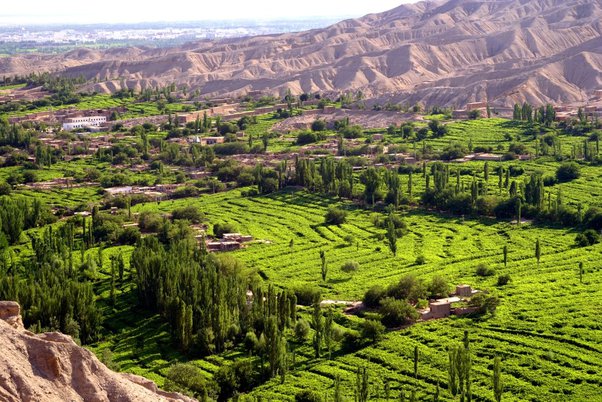
Finally, let’s talk about the main crops such as rice, wheat, and corns in China. They are the most important foods of all, not only to human beings but also to animals such as pigs, chickens, and cattle that produce meat and milk.
Here is a simple comparison between the top four producers across the world:
Arable Land: China 1086 India 1579 EU 1091 US 1631 (1000 km2)
Rice: China 208.1 India 169.5 EU 3.1 US 9.2 (million tonnes)
Wheat: China 134.3 India 98.5 EU 150.2 US 47.3 (million tonnes)
Corn: China 257.3 India 26.0 EU 60.9 US 366.2 (million tonnes)
As you can see, China is an all-around top crop producer compared to the other three regions. However, for a population of 1.4 billion, this is enough to be “filling” but still far from enough if the Chinese want to achieve similar “well-fed” status in per-capita consumption in terms of the developed country standard just like the EU and US.
Currently, there is just not enough arable land for China to produce enough crops to raise 1.4 billion people to the well-fed status. And what’s worse, the arable land in China is quickly shrinking as more and more land has been used for industries and cities.
Location 7: Xingtai, Hebei, China 37°35’54.1″N 114°55’20.8″E
To show you how the Chinese were quickly using up their precious land, our next destination is the great northern plain of China. This is where the most crops are grown in China. (Picture scale: top to bottom 1500km)
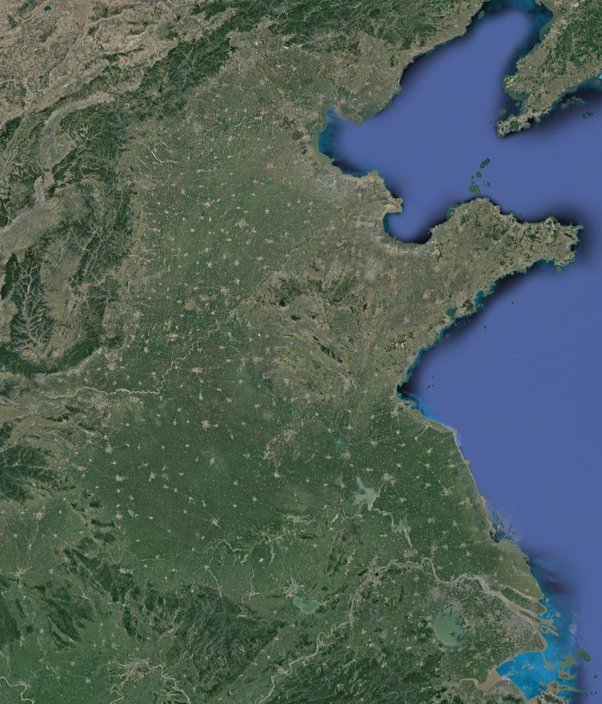
If we zoom in to any location in the plain, for example, the Xingtai city, a 4th tier city, a “small” city with 7 million people. (Picture scale: top to bottom 60km).

This is actually quite scary to many people. The green fields are the farmlands. These white dots are actually villages. Each “dot” contains around 500 people. The larger white regions are towns with around 10k to 100k people.
As you can see, as more and more people are getting rich and building large houses on the farmlands, those green land would be running out gradually. It is estimated that China is losing around 3,000 km2 area of arable land every year. Those arable land would be turned into “white” and dead concrete land. This is obviously a disaster and the Chinese government has been trying every effort to regulate the land uses. However, you just can’t control the huge momentum of “urbanisation” so easily.
Location 8: Qingyang, Gansu, China 35°41’00.7″N 107°40’38.3″E
The lack of arable land has been a “top concern” ever since the CCP has governed China. From the era of Mao Zedong, the CCP has been organising massive cultivations on hilly lands on different parts of China. There are countless examples. Here is the most significant one: Loess Plateau

This 640,000 km² plateau is actually not suitable for growing crops. But if you zoom in, you can see all the valleys, all the hills are converted to arable lands. From above, all the cultivated lands appeared like “roots”.
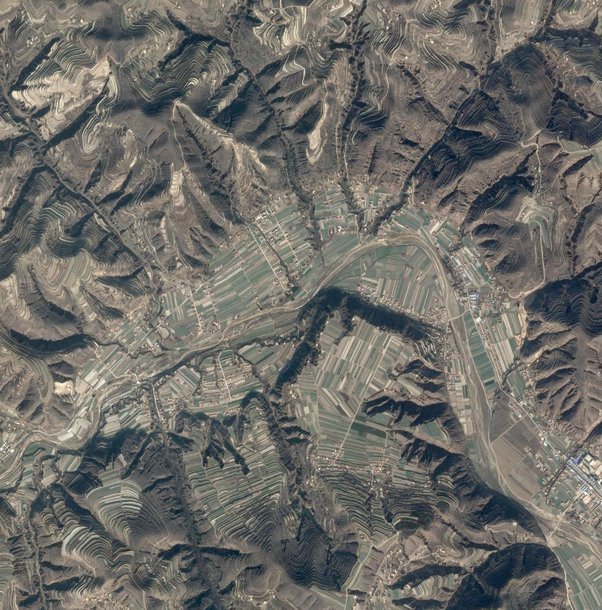
Just zoom in to any place, you would find all the hills are converted to terraces.
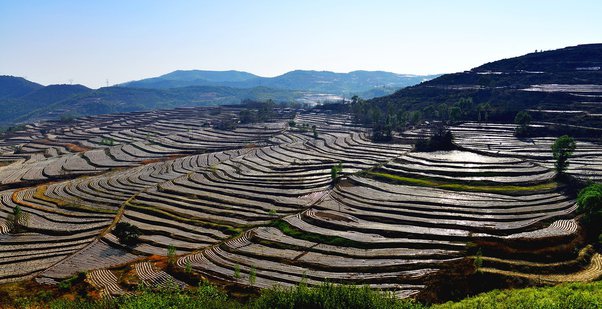
However, people have found that creating too much terraced land would cause land degradation and destructive mudslide during the monsoon season. From year 1999, the CCP realised that its previous massive cultivation campaign does not improve crop production significantly but instead has caused many floods and mudslides, then it halted the cultivation and proposed the “Returning Farmland to Forest Program (退耕还林)” campaign.
For those lands with low yield, farmers are forced to give up their land and they have to grow trees on them. And for the farmers who lost the land, the government would compensate the farmers with a fee that is equivalent to the field earnings.
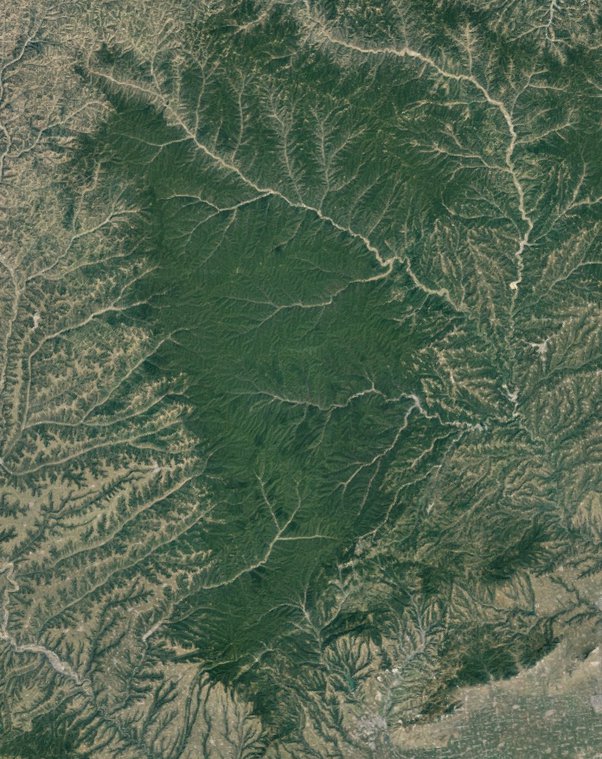
The above picture shows the impact of the forestation and afforestation. This is proof that after many lessons, the CCP has gradually grasped the key to sustainable development.
Xi Jinping once said: “China highly values ecological and environmental protection. Guided by the conviction that lucid waters and lush mountains are invaluable assets, the country advocates harmonious coexistence between humans and nature, and sticks to the path of green and sustainable development.”
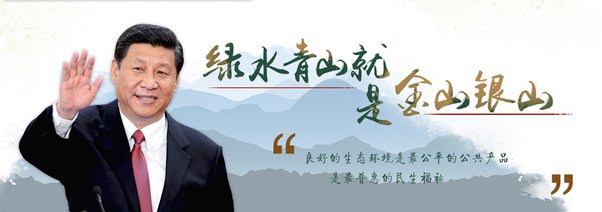
These are not empty words. Every “word” is backed by actual actions. Many people outside China may wonder why mainland Chinese still prefer Xi Jinping. One of the reasons is that he restructured the old bureaucracy of China to be more “environment focused”. For example, the local environmental officials now have the authority to impeach local mayors if the region has done badly in sustainable development.
The outcome of “Returning Farmland to Forest Program” is definitely causing the reduction of the arable land in China. However, despite the arable land degradation, thanks to the huge investment in agriculture technology, agriculture efficiency still improves, making its domestic crop production still increase.
One example is the new technology that allows you to grow rice using salty sea water.
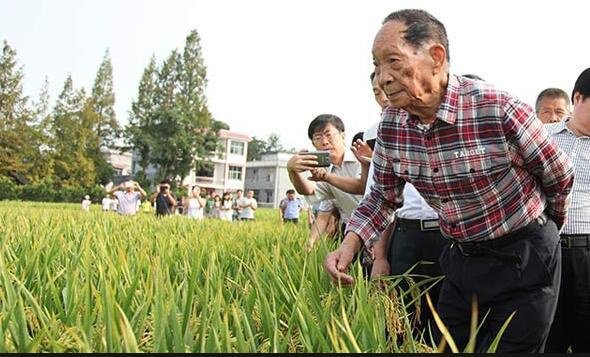
An 87-year-old scientist may have just unlocked the secret to growing rice in saltwater
Chinese scientists may have just found a new way to feed 200 million people
Despite the domestic crop production increase, China is still not self-sustainable in terms of rice, wheat, and corn. It has to import 10% of its annual consumption from the rest of the world. However, most of them are not directly for human consumption.
Example 1: Beer and Baijiu production

Since 2006, China has become the world’s largest producer of beer with 46.5438 million kiloliters, which is more than double that of the US. It has increased production by 4.9% annually. Besides wheat, China has to import most of the hop plant for beers from Germany and the USA.
And China is also the world’s leading producer of spirit alcohol. Most Chinese people don’t favor Whiskey or Vodka, but prefer drinking Baiju, which is more fragrant and rich in flavour. The Baiju production is around 13.6 million kiloliters, which is much more than western people consume. And the local rice wine made by individual Chinese households is not even counted!
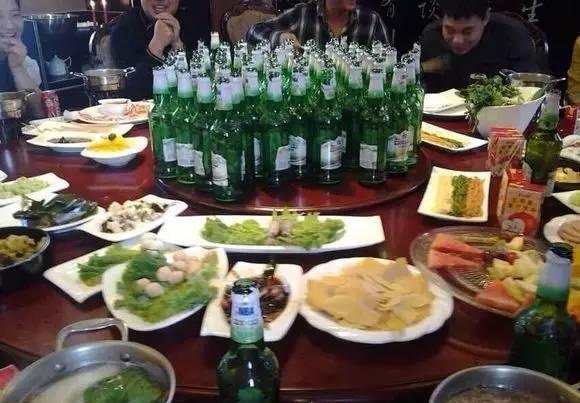
As a result, some parts of China has a much heavier drinking culture that the rest of the world is not even aware of. Let me tell you. It is much heavier than the British and the Russians.
Example 2: Pig and pork production
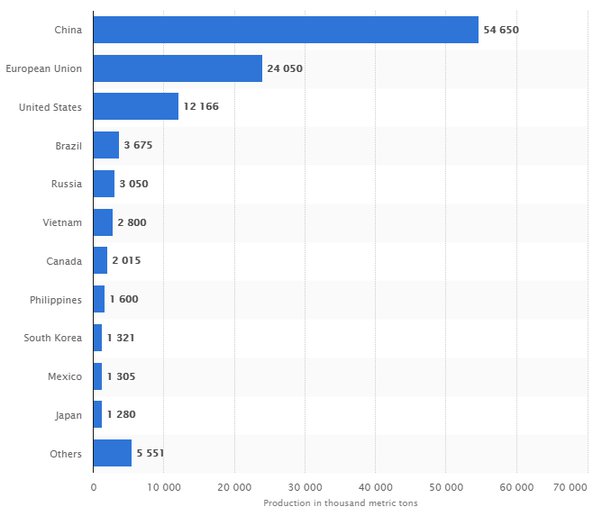
Global pork production
The above graph just shows how do the Chinese love pork so much. Some of the pigs raised in China fed on the corns imported from the USA and Brazil. This also applies to the chickens, cattle and other animals raised in China.
Conclusion
China is able to provide enough food which includes foods other than just plain rice or wheat. The variety of foods offered on the Chinese table is much more diverse and cheaper than within most developed places in the world. This applies to “poor people” as well. This is based on my personal experiences and observations after traveling to many different countries in Europe, the US, and Japan.
For example, in China, a group of eight people can sit at a round table, enjoying 20 different dishes including different meats, vegetables, desserts, etc. They don’t have to worry about religious restrictions, allergic concerns, and personal spaces.
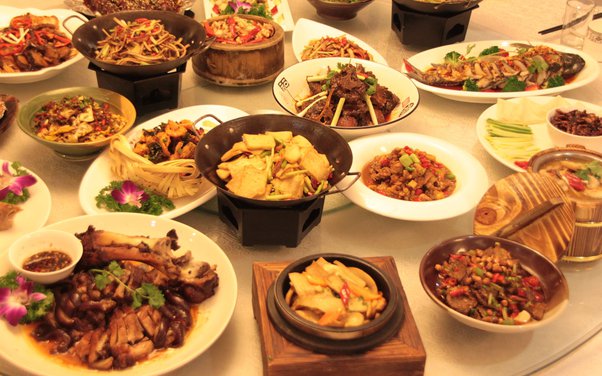
In Shandong, the total of this dinner costs around $50. The same set of 20 dishes could cost $150 in Beijing/Shanghai/Taipei, or $300 in California/Japan/Hong Kong, etc. And we are not counting the beers and drinks. Actually, most people in California/Japan don’t have the luxury to enjoy 20 different dishes at all but it is more than common in China.
After this extremely long post, I hope that you have learned something new about China and also now know how the Chinese can feed themselves far beyond just “enough”.
Costanza & Son | Seinfeld
Enjoy.
Slow-Cooker Creamy Chicken and Wild Rice Soup
Take 15 minutes to toss 7 easy ingredients into a slow cooker, and you’ll have a warm and delicious soup to satisfy hungry appetites.

Ingredients
- 1 lb boneless skinless chicken thighs (5 thighs), cut into 1-inch pieces
- 1/2 cup uncooked wild rice
- 1/4 cup fresh or frozen chopped onions
- 2 cans (10 3/4 oz each) condensed cream of potato soup
- 1 can (14 oz) roasted garlic-seasoned chicken broth
- 2 cups frozen sliced carrots
- 1 cup half-and-half


Biedronek
Let me introduce Biedronek. The name is a bit complicated to translate, but relevant to his story, so please bear with me.
Biedronek was found as a little kitten in the parking lot of a shop named Biedronka (Ladybird in Polish). Since “biedronka” is a female word and our little ball of fur was definitely male, he was named “Biedronek” which would be a male version of “ladybird”. A “Lordbird” of a sort.
Unfortunately, when he was found, he was dying. He was either ran over by a car or chewed on by a dog. His skull was partially crushed, his right ear was missing, and his right eye was severely damaged. Some good people rescued him and took him to a local foundation which saves homeless cats and dogs. This is his first photo, still in veterinary clinic, but already stable and recovering:

For some time, his doctors and foundation caretakers thought that he is permanently blind and deaf, but after several weeks it turned out he can see and hear after all.
This is Biedronek a little bit later:
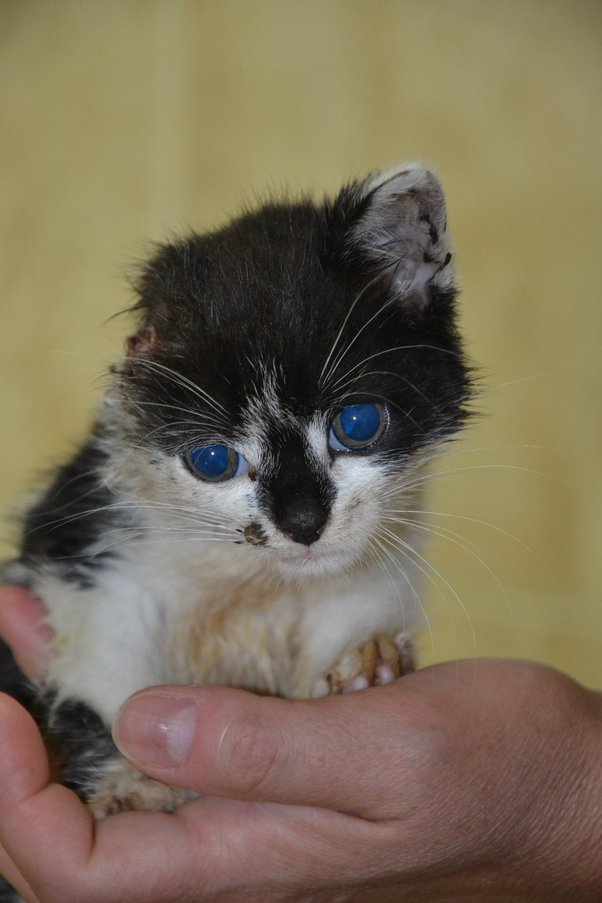
He looks cute here, but the damage to his head left him with a permanent scowl on his face, with his right canine and right side of the jaw exposed most of the time. This is probably why no one wanted to adopt him from the foundation for six months:

And after those six months we were looking to adopt a new cat, and we took an instant liking for Biedronek and his ugly mug. This is his first photo in our home (with our other cat, Carmen):

Biedronek is living with us for almost five years now, he witnessed our wedding, he moved with us to a new home, and was with us when our son was born. He is only a little disabled, his right eye does not work, and he lacks 3D vision, but compensates for it by memorizing every jump in the apartament. Now he looks like this:

Despite being almost five years old, he is still playful like a little kitten, and they get along with Carmen and our son very nicely.
Watch “Michael Hudson | American Empire Repeating History”
.
The Ghost and Mrs. Muir/Gene Tierney- L’Aventure de Mme Muir- Finale
So wonderful. Wonderful ending to a long duration love affair with a ghost.
What has President Xi Jinping done that has made him so liked and respected in China?
In 2013, he launched the Belt and Road Initiative (BRI), the most ambitious infrastructure project in human history. Today, over 149 countries have signed up — that’s more than 3/4 of the world’s nations! BRI is making many, many friends for China. The Chinese are brimming with pride.
He cleaned up corruption within the central government which was a sore point for the people.
In 2020, he finally eradicated extreme poverty (as defined by the UN) in China. This has been the goal of China for thousands of years and it was ultimately achieved under his watch.
In 2022, he successfully hosted the Olympic Winter Games. In addition to the 2008 Summer Games in Beijing, the Chinese are brimming with pride.
In 2022, he launched China’s first supercarrier, the Type 003 named Fujian. China is the only other nation capable of building supercarriers. The Chinese are brimming with pride.
In 2022, he put China’s own international space station, the Tiangong, into space and he invited all nations to participate in China’s space station program, including the United States (recall that USA banned China from the ISS). What a class act! The Chinese are brimming with pride.
He protected the people from COVID-19 with a stunningly low 246,618 total infections and 5,226 total deaths at the time of writing (data from Worldometer). For comparison, USA had 97,026,001 total infections and 1,075,338 total deaths. Let’s remind everyone that China has 4X the population of USA.
He made China the biggest pollution fighter on the planet:
He avoided the US trap of getting sucked into a proxy war over Taiwan. (Putin got sucked into a proxy war over Ukraine.) Xi Jinping was simply too damn clever for the Americans.
All of the above make Xi one of the greatest Chinese leaders who ever lived.
China’s World Domination Through Trade Networks
.
Fathom 1967 Anthony Franciosa,Raquel Welch,Ronald Fraser,Richard Briers,Greta Chi,Elizabeth Ercy
A great 1960s era movie! If you have a few hours, check it out.
At the least, just check out the first five minute into for a taste of real 1960s reality.
DM parses the Tunnel of Light
Finally, please enjoy these two videos where DM parses the remote viewing of the Tunnel of Light system.

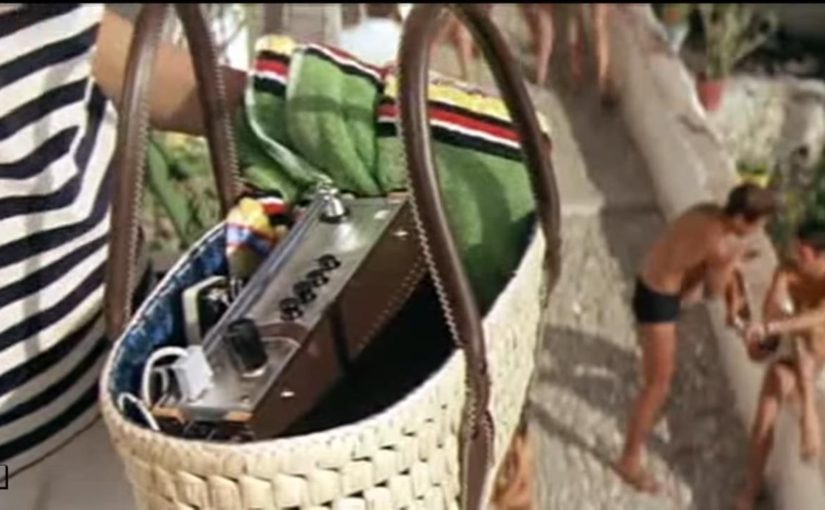



Huawei New cellphone
Help me here, seriously. I still live outside Shitcago. I would like a phone that can receive and send conventional text-messages, seamlessly and anonymously attach to my protonmail account, allow an untracked search engine and interface, and actually dial to other telecom addresses/numbers. I really doubt that any device is available that is truly untraced, but will entertain the possibility.
~~~
The Ghost and Mrs. Muir
MM: That is some pure gold. “Blast blast blast!”
A rare old movie that I can still watch.
Here is the link to the cellphone.
https://www.youtube.com/shorts/9E1SUke-Vy8